Property Council conference placarded by Peak Oil and Sustainable Population advocates in South Australia
 The Property Council of Australia's "Sustainable Urban Growth Conference" was the scene of lively protest for the first time as demonstrators against unsustainable population growth and infrastructure expansion handed out leaflets about peak oil and population to incoming conference participants. See also the second part of: Melbourne 2008: Life in a destruction zone
The Property Council of Australia's "Sustainable Urban Growth Conference" was the scene of lively protest for the first time as demonstrators against unsustainable population growth and infrastructure expansion handed out leaflets about peak oil and population to incoming conference participants. See also the second part of: Melbourne 2008: Life in a destruction zone
Today outside the Property Council's "Sustainable Urban Growth Conference", there was some unexpected - but long awaited - activity. For one hour during the registration at the beginning of the conference 9 people from Sustainable Population Australia (SPA) and Beyond Oil in South Australia (BOSA) greeted conference attenders with a big SPA banner and handouts for all the delegates.
Placard: Sustainable Growth is a scam!
Their placards were much in evidence, bearing slogans, including, "Sustainable Growth is a SCAM", "Sustainable Growth oxyMORONIC", "TODs mean too many BODs". etc.
Most conference attenders received a handout from the demonstrators. SPA Member and ex-Democrat, Dr John Coulter, was interviewed by Channel 10, although noise from traffic made this hard to hear.
Property Council Australia (PCA) conference organisers looked stunned as demonstrators posed for photographs with international invited speakers, but many in the throng appeared to have a good time.
Protest outside more cost effective than ticket to conference
The cost of attending the "Sustainable Urban Growth Conference" is beyond the means of most ordinary people. Protests outside such events seem like the only way that Australians can show what they think of the policies that the PCA boasts of influencing the government to adopt.
From a Property Council powerpoint presentation slide
Policies to grow Australia's population, reduce the taxes that property developers, investors, financiers and realtors pay, and policies for endlessly renovating and extending big infrastructure and housing, despite constant resistance from people whose lives are adversely affected by these policies, which increase the cost of living and decrease quality of life.
BOSA hits the right target
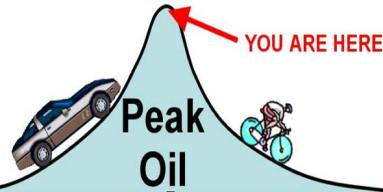
Beyond Oil South Australia is a group which supports radical action by government and individuals to cope with a future constrained oil supply and high petroleum prices. It seeks to bring about a clear understanding of where economic growth is leading and that growth requires an increasing oil supply. It supports population stabilisation and eventual reduction.
Population sociologist compares situation in 2002 at the Bracks Melbourne Population Summit
Population sociologist, Sheila Newman, who wrote The Growth Lobby and its Absence (2002) about how Australia is dominated by the growth lobby and France is not, commented, "I handed out a press release on behalf of SPA Victoria naming the members of the growth lobby's peak body (which was APop then and is now the PCA) on the steps of the Steve Bracks Melbourne Population Summit in 2002. The Financial Review ran the press release in its entirety, but SPA failed to take the matter up more widely, which always struck me as a tragic lost opportunity, because, since then the growth lobby has become frighteningly powerful and population growthism has been quasi-normalised by governments with the help of the mainstream press. Recently, however, Mark O'Connor came out with a book called Overloading Australia, which was distributed by SPA and which talked about the Growth Lobby."
Growth lobby undermining democracy
"It is great that they are now linking the push for population to the development lobby. Children should be taught of this menace to democracy and sustainability at school."
Newman said that, "Unfortunately democracy has gone out the window as government simply takes its directions from the PCA and similar growth lobby groups, which are internationally powerful and very wealthy. With the public almost excluded from decisions about their towns and cities, there is nothing left to do but picket the lobby groups."
"Let's hope that this is the beginning of a whole new trend in grass-roots democracy." Newman is also the editor of The Final Energy Crisis, (Pluto Press, UK, 2008), which is about Peak Oil, alternative energies and population scenarios.
Michael Lardelli of BOSA can be contacted on E-mail: michael.lardelli[at]adelaide.edu.au or phone: (08) 8303-3212
Wilsons Prom Fire - Gross ecological neglect or deliberate slaughter?

During February's bushfires, the Victorian government's Department of Sustainability and Environment (DSE) has allowed nearly all of the natural ecology of the northern half of Wilsons Promontory to burn. Is the Prom fire (now having destroyed 24,800 hectares of native habitat) being deliberately left to burn by DSE? DSE and CFA have protected private property at Tidal River and Yanakie. So is what's really happening down at the Prom away from public scrutiny?
See also "Wilsons Promontory – DSE fire management risking local extinctions" of 26 Feb 09.
During February's bushfires, the Victorian government's Department of Sustainability and Environment (DSE) has allowed nearly all of the natural ecology of the northern half of Wilsons Promontory National Park (The Prom) to burn.
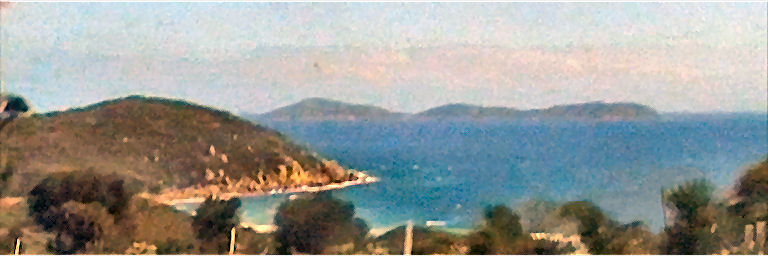 Out of control? Lack of resources? Or has The Prom fire (now having destroyed 24,800 hectares of native habitat) in fact been deliberately left to burn? DSE in collaboration with the Victorian Government's CFA have protected private property at Tidal River and Yanakie. So what really has been going on at The Prom behind the fire barricade out of public view? Why was the small fire north of Sealers Cove not extinguished on Friday 13th February when it was nearly out? Why after three weeks with mild weather conditions has this wildfire not been put out? Why, ahead of more forecast hot winds, has DSE risked this fire continuing?
Out of control? Lack of resources? Or has The Prom fire (now having destroyed 24,800 hectares of native habitat) in fact been deliberately left to burn? DSE in collaboration with the Victorian Government's CFA have protected private property at Tidal River and Yanakie. So what really has been going on at The Prom behind the fire barricade out of public view? Why was the small fire north of Sealers Cove not extinguished on Friday 13th February when it was nearly out? Why after three weeks with mild weather conditions has this wildfire not been put out? Why, ahead of more forecast hot winds, has DSE risked this fire continuing?
Is this in fact an opportunistic prescribed burn...thanks to lightning? Is it in fact because the DSE doesn't want the fire out..not until its prescribed burn area is burnt?
A DSE operational fire planning document sourced from the Yarram Fire Distict (which includes The Prom) shows that most of The Prom that has now been burnt is in fact part of DSE's 'Planned Burns' for 2009, 2010 and 2011 anyway. The DSE map (attached) shows no fires history for the northern half of The Prom.
...'so quick let's burn it, lest it burns!'
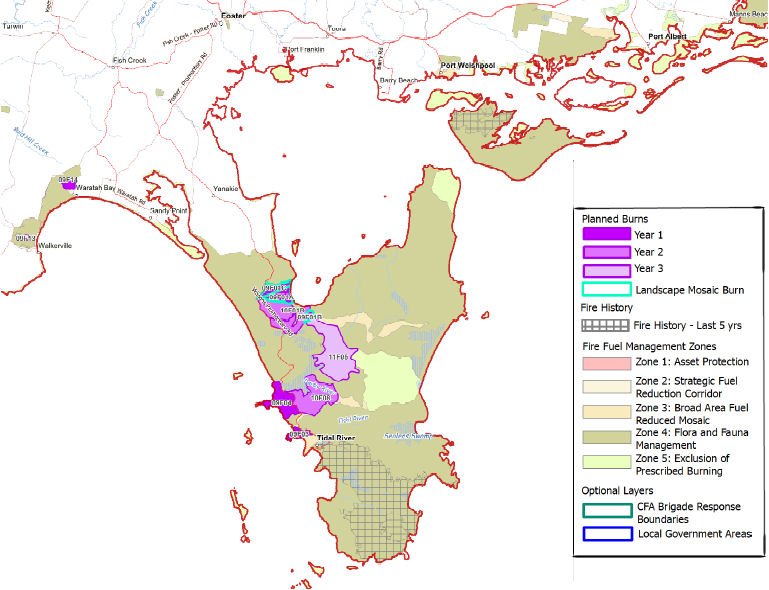
[CLICK MAP TO ENLARGE] Yarram Fire Operations Plan 2008/09 - 2010/11 - showing most of Wilsons Promontory colour coded for planned burning. ©Firemap Tue 14th Oct 2008
On this DSE planned burn map of The Prom, no areas are off limits from burning save the few villages and small pockets of private property and what the DSE has mapped as Zone 5 'Exclusion of Prescribed Burning'.
All other natural bushland areas of The Prom have been targeted by DSE for burning anyway.
This prescribed burning culture labels all bush hazardous 'fuel' and a demonic threat. Instead of putting out the fires in bushland they let the bush burn and all the native animals burn alive in the process.
They brag... 'we save houses, the bush will grow back so what's the problem?'
The 'Department for Sparks and Embers' is living up to its name.
But who's responsible for the fauna?

See also "Wilsons Promontory – DSE fire management risking local extinctions" of 26 Feb 09.
Self-censorship and opinion on population numbers
Christopher Ryan of Antioch University New England is in the dissertation phase of his doctoral program and the central question of his research relates to self-censorship of personal views and ideas that may be unpleasant, controversial, or uncomfortable. Most specifically, he is iinterested in specific concerns people have that lead to their self-censorship behaviors.
He thinks that the area of population numbers is one of those issues, like growth generally, that elicits significant visceral negative reactions and thus self-censorship. He believes self-censorship may be a common response by people who hold strong views about population.
He has designed a questionnaire to find out what may be happening. The questionnaire is at http://www.surveymonkey.com/s.aspx?sm=F1xytz_2fF_2fPl31pjFaIMzcg_3d_3d
One facet of the research is the part of the "spiral of silence" theory that suggests that self-censorship behaviors mask how important or widespread certain beliefs may actually be. He hopes to use this work to show that in topics like population, self-censorship may be holding back a groundswell of concern over this vital issue.
Christopher Ryan has a blog called The Localizer Blog (http://thelocalizer.blogspot.com)
Topic:
Independent candidate seeks categorical assurance against privatisation from Laurence Springborg
This letter is the second part of my response to Laurence Springborg's answer to an e-mail I sent to him and a number of other candidates. That initial e-mail which included my response to a questionnaire from the Save the Mary River Brisbane Group I recently sent him. (published on
citizensagainstsellingtelstra.com
(now archived by Australian National Library's Pandora service).)
Dear Lawrence Springborg,
Privatisation of water, Queensland Rail, electricity generators, etc
In your previous letter to me you omitted to respond to my question:
"Will (you) commit (yourself) now to opposing the privatisation of any of Queensland's water infrastructure during the next three year Parliamentary term?"
I ask this because I perceive there is a serious risk that either your Government, or a returned Bligh Government, will continue past policies of selling off Queensland's family silver as short-term, short-sighted fixes to Queensland's structural fiscal problems. (I would argue that these problems are largely avoidable and caused by the Queensland Government's unnecessary encouragement of population growth.)
As I have argued in documents elsewhere on this site 1, Contrary to the promises of privatisation proponents, almost every privatisation has been a disaster for the public interest. This includes the privatisation of the SGIO enacted by both LNP and Labor Government's, Telstra2, the Dalrymple Bay coal loader3, the Golden Casket, Energex, Ergon, TAB, the Commonwealth Bank, QANTAS, etc. etc.
I have also described elsewhere4 how I was personally affected by privatisation, when I lived in Warwick in your electorate in 1997. In that year, the Borbidge Liberal National Government effectively privatised the TAFE college computer support services by outsourcing them to UniSys. As an additional consequence, the Warwick TAFE college was forced, in 1998, to sell the Flexi Net Internet Service Provider (ISP) to a private local consortium. Although I had worked extremely hard to build up the service since 1996, and actually saved the business after the transfer, I lost my job soon after. Before long, Flexi Net was sold to the Ipswich-based HaleNet ISP, which, in turn, a few years later was bought out be a Victorian based ISP.
Thus my own career was seriously harmed, the Warwick community lost a local ISP and I have good reason to believe that the Southern Queensland Institute of TAFE (SQIT) lost an opportunity to become the ISP for Southern Queensland.
So, like many other Australians, I know from my own direct experience how harmful privatisation is.
It should therefore come as no surprise that all opinion polls indicate overwhelming public opposition to privatisation. In events chronicled on this site, but poorly reported in the mainstream media, last year, when the NSW Labor Government attempted to privatise the government owned electricity generators, polls showed at one stage 79% public opposition and at another stage 85% public opposition. Fortunately, for the people of NSW the Liberal National Opposition acted in a principled democratic fashion and blocked the privatisation legislation.
I believe that the Queensland public, as the rightful owners of Queensland Government utilities, are entitled to be consulted before any further assets are sold off, in particular, our water utilities, our publicly owned electricity generators, and Queensland Rail (QR).
So, I need to ask you: Will you give your firm categorical assurance that no more publicly owned assets will be sold off in the next term of a Springborg Liberal National Government?
I earnestly hope that this e-mail will cause you to give the firm commitment to Queensland electors that I am seeking. If you are unable to give this commitment, however, then I will consider privatisation to be an issue at stake in these elections. In such case I will maintain that the issue has to be properly discussed before the Queensland electors.
It is my view that the vast majority of Queenslanders opposed to privatisation are entitled to see those who remain in favour of privatisation justify their position. They are also entitled to know which candidates are firmly against privatisation.
If the Liberal National Party cannot categorically rule out privatisation, I will therefore be asking you or another LNP representative to publicly debate this question with me.
I will also be debating this issue with members of the Labor Party, including Treasurer Andrew Fraser at a "meet the candidates" night on Monday 16 March.
Thank you for your attention and thank you again for your reply.
Sincerely,
James Sinnamon
Pro-democracy independent candidate
for Mount Coot-tha
Footnotes
1. ↑ See section "End privatisation - stop the liquidation of Queensland" in "Why I am contesting the Queensland state elections as an independent" of 8 Mar 09.
2. ↑ As convener of Citizens Against Selling Telstra, I campaigned, ultimately unsuccessfully against the full privatisation of Telstra. See citizensagainstsellingtelstra.com. The catastrophe of full privatisation, the latest manifestation being Telstra's planned answer phone rip-off, could have been avoided if Liberal National Senator Barnaby Joyce had simply kept his promise made to Queensland electors in 2005 to oppose privatisation. (see "An open letter to Queensland National Senator Barnaby Joyce" of 12 Sep 05)
3. ↑ See "Costello blasts Dalrymple Bay privatisation" of 22 Mar 09 and "Feds Set to Repeat Australian Failure in Ridley Privatization" (MS Word document) of 26 Oct 05 by John Cummins, Canadian Federal MP about planned privatisation of Ridley Island Coal Terminal. He wrote, "Privatization of Australia's Dalrymple Bay Coal Terminal in 2001 has been a disaster the federal government seems determined to impose on Ridley Terminals."
4. ↑ See footnote in "Why I am contesting the Queensland state elections as an independent" of 8 Mar 09.
Steve Irwin's dad visits Wildhaven after Black Saturday bushfires
 Since Black Saturday - Feb 7, 2009 - when Australia's worst-ever bushfires on the hottest day in Victoria's recorded history completely destroyed all infrastructure at Wildhaven animal rescue and release center, Alan and Stella Reid have had a few visitors, including Steve Irwin's father, Bob Irwin, and Maryland Wilson of the AWPC, and four kangaroos that also escaped with their lives. Allan Reid tells an incredible story of his own survival as the place burned to the ground leaving him and perhaps four kangaroos alive. Please consider donating money for hay and rebuilding.See alsoImportant Wildhaven Shelter in St Andrews NE Victoria perished needs rebuilding and video.
Since Black Saturday - Feb 7, 2009 - when Australia's worst-ever bushfires on the hottest day in Victoria's recorded history completely destroyed all infrastructure at Wildhaven animal rescue and release center, Alan and Stella Reid have had a few visitors, including Steve Irwin's father, Bob Irwin, and Maryland Wilson of the AWPC, and four kangaroos that also escaped with their lives. Allan Reid tells an incredible story of his own survival as the place burned to the ground leaving him and perhaps four kangaroos alive. Please consider donating money for hay and rebuilding.See alsoImportant Wildhaven Shelter in St Andrews NE Victoria perished needs rebuilding and video.
Bob Irwin of the Australia Zoo between Alan and Stella Reid at Wildhaven 11 March 2009
Phone and electricity still not reconnected
Although the Reids at Wildhaven have had a number of visitors wishing them well, after thirty-one days since the fires on February 7, they would very much appreciate a visit from Telstra to reconnect the land-line and they desperately need an electrician to come and inspect their telegraph poles and certify that the electricity may be reconnected.
Bob Irwin's visit and the Department of "Sustainability" (DSE)
I have lots of film of my own recording a visit on March 10 to Wildhaven, but I was glad of this photo I was sent of Bob Irwin with Allan and Stella Reid. It was taken when he visited them at the devastated Wildhaven site yesterday (March 11, 2009).
Bob Irwin's visit probably means a lot to the Reids because it shows that their serious and significant work supporting wildlife has been recognised by people respected world-wide in the hands-on wildlife-help and species-preservation community. Ironically so, since I also know that the Reids were quite hurt recently to be passed over for a small amount of funding by the Victorian Department of Sustainability (DSE), apparently with a remark that the applicant 'lacked experience'.
Do DSE realise how much damage their lumpen conduct towards wildlife and so-called 'Greenies' does?
I am probably not the only one who thinks that that remark reflects pretty accurately where the DSE is at. Stella and Allan have been running their wildlife shelter for 22 years. DSE could learn from them - that is, if it could first master its arrogance. The Reids built Wildhaven 11 years ago and must have wondered what hit them when the ignorant knockback came.
Wildhaven on March 10, 2009
It is worthwhile noting that the DSE insult still comes to the Reids' minds, even after having Wildhaven totally wiped out by the Black Saturday fires, and almost being wiped out themselves.
Few of the wild creatures they lived for survived
Both of them weep every time that they mention the animals that died - "the kids" - as they refer to them affectionately, although the rest of the time they put on a brave face. Something like sixty-plus injured wildlife they were treating or in the process of releasing, of which each one was an individual with which they had a close relationship, will probably never be seen again. The dam below was full of the bodies of animals for whom the water did not prove sufficient shield against this super-hot fire. The CFA and the police helped the Reids to collect tens of dead animals and then took them away.
Between three and five kangaroos they knew probably survived. Alan wonders if they crawled into wombat holes. A doe, her joey and her adult daughter (known by names I cannot recall) came back to Wildhaven with burned paws. They were darted with anaesthetic so that the Reids could send them for treatment to a wildlife-rescue place that hadn't been burned out. They have all recovered, but, worryingly, the doe jumped the fence of the wildlife-hospital with her joey and has not been seen since.
When he was driving down the hill in the evening away from the scene of the fires, Alan glimpsed a male kangaroo he knew well, travelling alongside his car, and was amazed to see that the roo appeared unscathed. (I cannot remember his name either; it seems very disrespectful of me.)
The Reids also hope that the big male kangaroo with mending burned paws, who has been eating hay on the outskirts of the camp, is who they think he is - "Boof" - pictured below in happier times, with Stella.
Stella & Boof in happier times
Grass is starting to grow back, but it is very short and still brown, because there still has been little rain. There is absolutely nothing for animals to graze on. Even the micro-biota in the earth (representing a lot of carbon) were burned and the top layers are sterile. Stella and Alan are buying bales of hay (at about $17.50AUD each) and putting them out for the animals that survived. The Department of "Sustainability" does absolutely nothing for these animals, on pseudo-scientific macho grounds. Since its main job is to grant licences to shoot and 'harvest' our pitifully sparse wildlife, it is not surprising that its policy is to let them die, even though a million or more of Victoria's animals died in these fires, many from threatened species. The Reids walk into the burnt stick-like trees at dawn and at dusk, looking for old friends who may have survived and for any animal they may be able to help. The Reids deserve the salaries currently going to DSE CEOs. They survive on handouts at the moment. Don't get me wrong - they are not complaining - I am.
Thousands of wildlife photos lost
Stella's wildlife photos are much admired because she can get so close to the subjects and the animals look her back in the eye affectionately or with recognition and readable, respectful expressions. She lost thousands of such extraordinary animal photos in the fires, but almost immediately she was able to get her hands on a computer, she put together a CD of the photos she had received back from correspondents over the years. There is so little left now of the youngsters and adults she knew and loved so dearly. She takes us later into the caravan they are living in now to watch it and tells us the names of the animals in the pictures. It is very sad.
Donations
I brought some warm jumpers (because we are entering autumn) and a doona. Alan said they don't need clothing but Stella accepted these and said she will put the doona in the back of the ute for when she transports animals, to make a soft bed. It is good that my doona will be appreciated. Mostly they need money to buy food and treatment for animal survivors for the next few months to two years. The temporary camp they are living in on the burned site is made up of a caravan, a temporary showroom and a porta-potty which have been lent to them.
As I approached the camp I was struck by the surreality of this view, and I started taking stills.
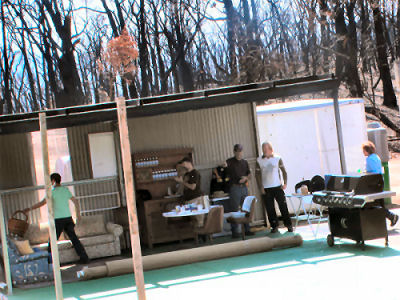
The portable showroom which was lent as shelter to the Reids, looked like a tiny stage-set in a vast empty landscape and the people preparing afternoon tea there looked like dolls in a dolls' house. Stella and Alan had stayed up half the night painting the concrete block in front green, so it looked like a pretend-lawn before a very neat dolls' house, set down by some giant careful child in a vast neglected yard. I set the tripod up again with the digital camcorder running and when I look the film later that night, it is like watching people walking on and off-stage and hearing them talking. I almost find myself listening for clues to some other scripted drama.
It was hard to tell whether it was a strain or a pleasure to receive visitors. Stella had bought a mobile phone to alleviate the isolation. We had come with a visitor from England who is interested in kangaroo-rescues and the Reids have transformed this open temporary building into something like a pleasant lounge and dining-room. We felt very welcome and at home, and probably that's the way they make the wildlife feel.
Stella has been a member of the Country Fire Authority (CFA) for about 9 years and she had been with Steve Martin (the blond man in the beige top pictured above) fighting a fire on a distant ridge while Alan, her husband, was at home with the animals. She had looked across when there was a sudden burst of fire from that direction, wondering if it was Wildhaven. Others thought that it probably wasn't. But it was. Alan saw the fire coming from the hill where, unbeknowst to him, his wife was, and thought he had about 20 minutes. He says he found out he had only seven minutes. I am putting a video up with his story and footage of Wildhaven at http://www.youtube.com/watch?v=Td6tWKDC62s for anyone who is interested.
The Future
We all hope that Wildhaven will soon be back in working order. When that happens the future will take over from this terrible past and slowly the scars will heal. They must be very deep and painful scars though, after 11 years in this place, with a past composed of very close connections with the secret lives of thousands of individual creatures, animals that most humans don't even notice, let alone care about. Indeed the Reids have spent 22 years in this region doing this work, all told.
Animals one lives close to are almost a part of one. My dog Nero died after 16 years recently and it was like a door slamming shut on the past and a familiar star disappearing from the sky. Although his elderly sister is still alive, my life seemed to make no sense for months. Even now it doesn't feel right. How difficult it must be then to see an entire galaxy disappear and the ground change irrevocably underneath your feet.
You can send money for hay and equipment etc here:
by direct transfer
Bank details:
Stella Reid
Commonwealth Bank of Australia
BSB: 063 222
Account: 10262617
By cheque
Postal Address
Stella and Alan Reid
c/o St Andrews Post Office
10 Caledonia Street,
St Andrews
Victoria 3761
Australia
By PayPal
PayPal address : [email protected]
Please state there: "for Stella's kangaroos"
The PayPal option might be the most convenient for International donations.
Lawrence Springborg responds to Brisbane Save The Mary River Questionnaire
On 8 March I responded to a questionnaire from the Brisbane Save The Mary River Questionnaire group and sent copies to other candidates contesting the seat of Mount Coot-tha, as well as to Premier Anna Bligh and to Opposition Leader Lawrence Springborg. Lawrence Springborg replied on the same day by 12.30PM. His response is below and my response to that is further below.
Opposition Leader Lawrence Springborg's response
Dear Mr Sinnamon

Thank you for your email received this morning regarding the proposed Traveston Dam.

The Traveston Dam is a ridiculous proposal, and it is clear that the Labor Government has not followed due process or properly considered the social, environmental and economic implications of building a dam at Traveston Crossing.
In fact, this dam has never been even mentioned in the various water planning reports developed over the past 12 years, and was resoundingly rejected in a 1994 report into possible water supply sources for the Sunshine Coast and Mary Valley.
I fear the Premier only announced this project to be seen to be doing something about the water crisis gripping the rapidly growing south east Queensland region, a crisis the Government created by failing to plan and develop new water supply sources over the past 10 years.

I have traveled to the Gympie region on a number of occasions to meet with affected landholders and inspect the proposed dam site.
We have confirmed we would not build the Traveston Crossing dam. In addition, the LNP has a broad ranging plan to fix the water crisis the Labor Government has created by building more appropriate water infrastructure, ensuring more water is recycled and ensuring water is used more efficiently.
The establishment of a desalination plant close to Bribie Island could provide water to South East Queensland at less than half the price of water from the proposed Traveston Crossing Dam and more importantly it would not be dependant on rainfall. Desalination can provide water in two and a half - three years whereas Traveston Dam won't deliver meaningful water supplies until 2013.
Shadow Infrastructure Minister Fiona Simpson and Shadow Sustainability, Climate Change and Innovation Minister David Gibson have stated in media releases that the desalination barges proposal proved water could be delivered faster and cheaper than Traveston Crossing Dams.
I invite you to visit www.climateproof.com.au for details of the LNP's Climate Proof and Water Policy.
Thank you for taking the time to bring your views to my attention.
Yours sincerely
Lawrence Springborg
Leader of the Opposition
Leader of the LNP
My further response
Dear Lawrence Springborg,
Firstly, I greatly appreciate your very prompt response to my query (in 2hrs 20 minutes).
And thank you for having reaffirmed the Liberal National Party's (LNP) opposition to the Traveston Dam.
Thank you, also, for explaining some of the background to the decision by this Government for its choice of Traveston as the site. According to former Labor MP Cate Molloy the site was chosen, not because it was the most suitable site, but because the affected residents were solid National Party voters and, hence, deemed by this Government to be politically expendable.
The details of the Opposition's proposed alternatives to the Traveston Dam were also most helpful.
However, my own stance is against desalination (which the LNP supports) and against industrial water recycling (which I understand the LNP also opposes) and for more ecologically sustainable solutions. I oppose water recycling and desalination because they are technologically complex, expensive and depend upon the burning of fossil fuels. I believe we should move back to simpler more environmentally friendly technologies such as rainwater tanks and restrictions on water use.
However, any further water restrictions must be made with the clear understanding that they will not be means to allow the Queensland Government to cram even more people into Queensland. Rather they must only be a temporary measure to eliminate any necessity to dam the Mary Valley or Wyaralong in the Beaudesert region or to build any more desalination or recycling plants.
Population growth, the ultimate cause of Queensland's water crises
This brings me, again, to the main point from my previous response to the Save the Mary River Brisbane Group.
Your letter, by implicitly accepting that South East Queensland's population must necessarily continue to grow rapidly, pre-empts the most obvious solution to the water crisis.
If Queensland had not doubled its population to 4 million from 1974 to 2005, there would have been no water crisis. If Queensland's population increases by several more millions in coming years, as your letter implies, further water crises are practically guaranteed.

In fact, it is not predetermined that Queensland's population will continue to grow, rather it is a conscious choice made by governments, in this case, the Queensland and Federal Labor Governments. They could just as easily choose to end population growth.
Every democratic society have the right to decide what its population will be, contrary to what the newspapers and others promoting population growth would have us believe. I believe that choice should be made available to the public at this election.
I therefore ask that you acknowledge the obvious harm caused to Queensland by population growth, not just in regard to our water security, but to our overall quality of life, to our economy, our finances, our natural environment and our long term sustainability. Accordingly, I also ask you to commit an incoming Liberal National Government to reversing the Bligh Labor Government's irresponsible encouragement of population growth.

In my own experience, all the supposed economic arguments in favour of population growth and high immigration have not withstood intellectual scrutiny, for example, in on-line forum discussions. Population growth doesn't pay for itself. For instance, the building of new infrastructure to provide water for a larger population have cost Queenslanders financially in higher water and council rates. Another cost is the massive bill for the state Government's and Brisbane City Council's road, bridge and tunnel building projects, which have been explained as necessary due to past population increases.
If you still have any lingering doubt that further population growth is harmful, I urge you to obtain a copy of Mark O'Connor's Overloading Australia published in 2008. It costs only AU$20.00 and its 184 pages are very easy to read. Almost every conceivable argument in favour of population growth has been challenged and shot down in flames.
I will address the subject of privatisation in another email.
Please also feel welcome, as an alternative to e-mailing me directly, to post further comments in response to this correspondence to my web site here.
Yours sincerely,
James Sinnamon
Pro-democracy independent candidate
for Mount Coot-tha
Coal mine threatens Queensland Nature Refuge
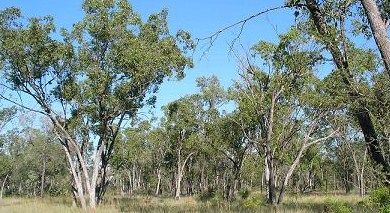
Currently at risk is the 7,912 hectare Bimblebox Nature Refuge in central-west Queensland which is in direct line of a massive open-cut coal mine planned by Clive Palmer’s recently acquired Waratah Coal Incorporated. The proposed mine is one of several being planned for the region and is anticipated to produce around 3.12 billion tonnes of coal over its lifetime, which translates to around 7.2 billion tonnes of CO2-equivalents. However, the contribution the mine would make to an already over-loaded atmosphere is only one of the dirty details. A brief history of Bimblebox reveals a major inconsistency in current government policy which provides inadequate protection for vital conservation areas from development interests.
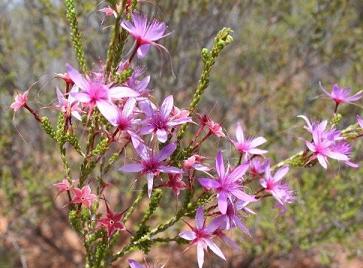
The property was purchased in 2000 by a several concerned families, with the assistance of about $300,000 from the Federal Natural Reserve System program. This was prior to the enactment of the Queensland land-clearing legislation and it was acquired for the express purpose of securing it as one of the few uncleared properties in the Desert Uplands, a region classified as a National Biodiversity Hotspot but which has less than 3% of land protected in conservation reserves.
In 2003, the Bimblebox Nature Refuge Agreement was signed with the state government to “permanently protect” the property’s conservation values. The perpetual Nature Refuge Agreement (category VI Protected Area under the IUCN classification system) is a legal covenant covering the entire property.
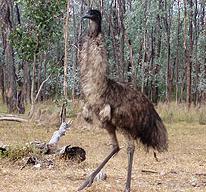
During the last five years, Bimblebox has become host to a number of long-term research projects conducted by the CSIRO, DPI&F, Birds Australia, EPA and the Queensland Herbarium. It is also a test case for sustainable grazing, since the property is carefully managed with a small herd of beef cattle. Profits are returned for native habitat rehabilitation and conservation.
Now that coal has been found under the soil of Bimblebox, all its above-ground assets are little more than over-burden to the coal company and the state government hungry for revenue. It is evident that nature refuge agreements are practically meaningless when coal is discovered. The agreements allow some minor provisions to reduce environmental harm during the exploration phase (a number of these provisions were violated during the exploration on Bimblebox - see attachment), but in the case where a mining licence is sought, nature refuge status guarantees no protection. Not even National Parks are secure from mining interests, as the Ranger uranium mine the middle of Kakadu National Park starkly demonstrates.
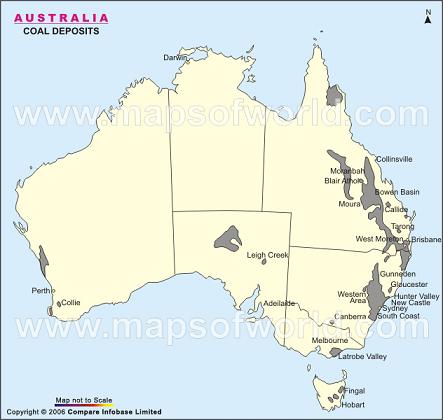
Unfortunately Bimblebox is not alone. Around 100 Queensland nature refuges are covered by mineral exploration permits, and about half of these are for coal. The extensive coal beds that underlie a large portion of Australia’s east coast (see 'Coal Map' below) indicate that this issue is not going to go away. As well as the impact on mine sites many other areas are effected with large scale developments, for instance, threatened species and ecosystems exist along the length of the planned water supply, rail and port infrastructure proposed by Waratah.
Cropping farmers on some of Australia’s most fertile agricultural land are facing similar threats from coal companies, and are having to get well organised in the defence of their land and livelihoods. However, without a comprehensive regional and national assessment of land use and climate priorities, it is likely that there will be significant struggle ahead for ‘David’ land holders against the ‘Goliath’ coal industry. In the case of Bimblebox, countless hours of volunteers’ time have already been invested in writing submissions, letters to ministers, the creation of a website and a petition – trying to explain why digging up crucial conservation and productive areas will have significant and irreversible negative impact on biodiversity, soil, and ground water.
Surely there is a clear case for important conservation and agriculturally productive areas to be exempt from mining activities.
What you can do: 1. Queensland residents can sign the petition here, the text of which is to also be found here. 2. On 21 March, vote for candidates in the Queensland elections opposed to the the expansion of the Queensland Coal industry. One such candidate is James Sinnamon who is standing as an Independent for Mount Coot-tha. 3. To learn more of the devastation with which the Bimblebox Nature Refuge is threatened by the proposed open-cut coal mine, please visit www.bimblebox.org.
Why I am contesting the Queensland state elections as an independent
End privatisation - stop the liquidation of Queensland
End Queensland Government encouragement of population growth
Demand action against homelessness and housing unaffordability
Labor's coal exports - a crime against this and future generations of humanity
Why a vote for me is not be a wasted vote
To intending Labor voters:
To intending Green voters:
To intending Liberal National Party voters:
What you can do
I am standing for Parliament because I believe Queenslanders need an alternative to the blind alley into which either of the major parties, both committed to promoting the interests of wealthy corporations above all else, will lead us. The direction in which we are now headed, under Labor, is towards, social, ecological and economic ruin and a change of Government to the alternative of the Liberal National Party will not change that.
The only way that this can change is if for all the Labor and Liberal National Party corporate glove puppets to be removed from office and for them to be replaced with people who are prepared to stand up for their communities against powerful vested interests.
All over Queensland the rights of small communities, which are trying to preserve their way of life, their livelihoods and their local environment, are being trampled by the Bligh Labor Government.

The plan to dam the Mary Valley, cynically chosen because the Labor Government judged the local community, which overwhelmingly votes Liberal National Party, as politically expendable,1 is only one of the more visible examples. The Labor Party has meted out similar treatment to many other Queensland communities, where local interests have stood in the way of developer profits, mining companies or tollway construction corporations. Indeed, the forced local Government amalgamations of 2007 were enacted by former Premier Beattie and the sitting member for Mount Coot-tha, Andrew Fraser, the then local Government Minister, in response to lobbying by the Property Council of Australia (PCA). Smaller local governments, like the former Noosa Shire Council, were more accountable to local communities than distant larger councils can be, hence smaller local governments posed obstacles to PCA plans.
As an elected representative, I would stand up for all local communities. I would move quickly to support the de-amalgamation of councils, where communities so desire2 and I will move to repeal the Community Integrated Planning Act. That act is a bureaucratic nightmare and undemocratically deprived local communities of any veto over development proposals.
I intend to raise the issues below, which, as far as I know, are not adequately addressed by any of the political parties:
End privatisation - stop the liquidation of Queensland
The privatisation of Queensland's Mackay and Cairns airports has barely been reported, let alone discussed in the newsmedia. The very recently concluded sale of the Port of Brisbane's stake in Brisbane, included in the same privatisation bill, has not even been reported outside the Hansard Parliamentary Reports. The stated reason for these sales was to raise funds to build hospitals.3
Other recent privatisations include:
- The Qld Government's stake in the Emu Downs wind farm in Western Australia4 in 2008;
- The Enertex (not be confused with Energex) gas business5 in 2008;
- The Golden Casket state lottery agency in 2007;
- Ergon Gas in 2006;
- Energex, the retail arm of Queensland's electricity generation utility in 2006;
- the Dalrymple Bay coal loader in 2001
- The Totalisator Agency Board (TAB) in 1999
- the State Government Insurance Office7 (the SGIO - now known as Suncorp) in 1998
In addition, much of Queensland's road and transport infrastructure is effectively privatised through Public Private Partnerships (PPPs). No doubt many de-facto privatisations have also occurred under the guise of out-sourcing. One such example was the disastrous out-sourcing of the TAFE's IT services to Unisys by the Borbidge National Party Government in 1997.8 Common land is sold off at every possible opportunity to developers or other private concerns, behind the backs of local communities, or even in the face of their strong objections.
The stated reason for the sale of the airports was to raise funds to build hospitals, whilst the stated reason for the sales of Enertex and the stake in Emu Downs wind farm was "to provide for a Climate Change funding stream". Energex and Ergon were sold to raise the necessary funds to build the Traveston Dam. If that dam proceeds, it will destroy the rural community of the Mary Valley and may well cause the extinction of the the Mary River Cod (Maccullochella peelii mariensis ), the Mary River Turtle (Elusor macrurus) and the Queensland Lungfish (Neoceratodus forsteri).
Clearly, if it is necessary for our Government to keep on selling off infrastructure in order to build other necessary infrastructure, or to meet recurring expenditure, then the Government and the State Treasurer, Andrew Fraser, are not doing their job properly.
Even if it were possible to establish that the ongoing liquidation of Queensland is necessary, the matter should at least be discussed openly with the Queensland public, who are, after all, the rightful owners of these assets.
That is why, on 17 February, before the elections were hurriedly called, I wrote this open letter to both Treasurer Andrew Fraser and Premier Anna Bligh:
"(I) seek your firm assurance that if you do intend to privatise any of these assets that you state your intention to do so to the public before the forthcoming elections, or, alternatively, that you will put any planned privatisations to the public as referenda."
I was particularly concerned that plans might be afoot to privatise our water infrastructure and Queensland Rail. If such plans are in the pipeline, then the Queensland public, who according to all recent public opinion polls, oppose privatisation, have every right to be consulted, if not at the election underway, then in referenda.
So far I have received no response from either the Premier or the Treasurer.
I will be putting a similar question to Opposition leader, Lawrence Springborg. I will try to ask every other candidate as well in the little time remaining before the election, and I will publish their responses on this web site.
End Queensland Government encouragement of population growth
According to Australian Bureau of Statics (ABS) data, Queensland's population doubled from approximatlely 2 million in 1974 to 4 million in 2005 (31 years later). Between December 2005 and June 2008 another 278,000 or almost 7% were added to Queensland's population as a result of unprecedented interstate immigration largely driven by record high international immigration into NSW and Victoria. If the average rate of the two and a half years to June 2008 continues, the population will double to 8 million by 2031 -- a rate even greater than that which Beattie told Queenslanders in December 2005 to expect (see below). And that is not taking into account the increases in the rate of immigration announced by the Federal Immigration Minister Chris Evans in May 2008.9
That the population increases have been detrimental, not beneficial, to existing Queensland residents should not come as a surprise. Traffic is ever more congested. Trains and buses are so crowded that many passengers have found themselves left at bus stops and stations during peak hours. Queensland residents are being made to pay ever increasing charges to build new water, electricity and transport infrastructure to cope with the influx of people. Public hospital waiting lists have blown out to the point where many just don't bother. Instead, people, having no alternative, take on board the enormous costs of treatment by private hospitals.
On 4 March 2009 the Courier Mail, in the story "Private fix for surgery", reported that Premier Anna Bligh had acknowledged growth in Queensland's population numbers had caused our public hospital system's failure to cope.10
Premier Anna Bligh, for her part has been most disingenuous, as both she and her predecessor Peter Beattie, have actively sought to bring about the population growth that Bligh now chooses to blame for the problems her Government faces. Both of them have played the Queensland public for fools over the question of population growth.
In April 2007, in the midst of the water crisis, Premier Anna Bligh dismissed any suggestion that Queensland should attempt to restrict population growth claiming that it "would have a very serious impact on the construction industry that a lot people rely on for jobs."11

interstate migrants to join its intolerable hospital
waiting lists and add to traffic congestion, bus
rage and housing hyperinflation.
On 8 December 2008, in anticipation of the birth of 4 millionth Queenslander, the Beattie government placed the pictured full page advertisement in the then broadsheet Courier Mail newspaper. The purpose of this advertisement was to present Queensland's population growth up to that point as inherently good and to promote more of the same.
The body of this breathtakingly irresponsible piece of propaganda, paid for by Queensland taxpayers, bears repeating in full:
"If you are visiting or thinking of a move to Queensland, you'll already know we are the nation's engine room. Our population growth is only rivalled by our economic and employment growth. We now account for 19.5% of Australia's population.
"Tomorrow's milestone and our economic success reflect that Queensland is the place to invest, work and play.
"Our economic growth rate is envied, our taxes are competitive and we have a cherished lifestyle.
"More than ever, people are investing in Queensland and moving their businesses and family here. You should join us! (my emphasis.)
"Please contact us today and we will let you know what the Smart state can do for you.
"Queensland's population reached 1 million in 1938, 2 million in 1974 and three million in 1992. We are projected to reach 5 million in 2022 and 6 million in 2040.
"We are projected to overtake Victoria as the second biggest state population wise, in 2044, with our share of of Australia's population increasing to 24% over the next 50 years.
"To keep building our Smart State, we need to foster and support our people's innovation, knowledge and skills. We need to keep Queensland growing and build on the opportunities, energy, vitality we're renowned for - we're doing just that.
"To all Queenslanders, I encourage you to warmly welcome our new arrivals."
The advertisement was signed "Peter Beattie MP Premier and Treasurer". At the foot of the page were the words, "Queensland the Smart State."
What Beattie neglected to mention was that the new arrivals would increase demand for scarce housing, which had already driven so many existing Queenslanders out of the housing market, or even the rental market. What he also neglected to mention was that the prospective newcomers' additional demand for water would be used by him as an excuse to try and destroy the Mary Valley rural community and threaten with extinction various endangered species there.
Water crisis created by Australian and State Governments
The following year, at a public forum on water, I asked Premier Peter Beattie to acknowledge that the water crisis had been made worse by population growth. I asked him if he was prepared on that basis to come out and state clearly that further population growth was not in the interests of Queensland and, moreover, if he would therefore desist from encouraging more population growth?
Peter Beattie initially thanked me for asking such a "good question". He then claimed (contrary to his words in the above-cited advertisement) that he wished so many people would not come to Queensland! However, by the time he had finished his very long winded response, he had managed to turn that wish around almost 180 degrees. He now said that Queensland needed more skilled people. (Presumably he did not mean 'skilled' people like myself, whose computer skills and degree had been deemed no longer current by recruitment agencies and implicitly by the Queensland Government since it was seeking new computer people rather than to retrain or help those many unemployed IT professionals already there.) He explained that skilled immigrants were now needed to cope with the problems caused by previous population growth. Finishing on this, he failed to provide a clear answer to my question, and of course, the microphone had moved on and the debate was over.12
The Queensland Government, as we all know, has continued to aggressively promote population growth.
It is truly difficult to understand why any political leader would seek to so deliberately harm the overall wellbeing of the society they have pledged, as elected parliamentary representatives, to look after, but that is what they have done.
The reason, as explained in another article "How the Growth Lobby threatens Australia's future", is that the Government's policies serve the interests of a small powerful minority which profits from population growth whilst the rest of the community pays with a declining standard of living, quality of life and democratic input.
Throughout 2008, rental increases got further out of control. By early 2009 even well-paid professionals were having difficulty meeting rental rises caused by the demands of apparently insatiably greedy landlords. Starting in early 2008, an established retail community in Latrobe Street Paddington was driven out by continuously increasing rents. In March 2009, unable to afford rent, which had doubled in the two and a half years since she opened her business, Joan Winter was forced to close the Baboa Gallery.
Demand action against homelessness and housing unaffordability
Instead of applying token band-aid measures, the Queensland Government must urgently take decisive action to help those it has left so much in the lurch in recent years.
First and foremost, it must immediately desist with its encouragement of population growth.
If anything is to be learnt from recent years, it is that we cannot rely on the inequitable and grossly inefficient private sector, if we are to ever achieve affordable quality housing for all Queenslanders. to meet our housing needs, we must re-establish the Queensland Housing Commission as a provider of quality affordable housing as it was when I grew up in Brisbane in the 1960's and 1970's. Whilst such a policy may cost us in the short term, in the longer term it should prove vastly cheaper than the current out-of-control private housing market.
Where people choose to own their own dwelling and not rent from the Housing Commission, state taxes must heavily discriminate in favour of them and against those who already own their own dwellings. The eventual goal of this policy would be to ensure that no-one owns more than home whilst others are deprived of owning any.
In the meantime action must be taken to protect private tenants from unreasonable landlords. Tribunals with special powers to protect tenants and to reverse the excessive rent rises that have been imposed upon many renters in recent years need to be set up. Certainly, where no demonstrable economic hardship will be caused to landlords, rents should be immediately reduced back to the levels of 2005.
Labor's coal exports - a crime against this and future generations of humanity
When, nearly seven decades ago, our society was threatened with invasion by Japan our country pulled together as one in order to defeat that threat. It has been calculated that we devoted 30% of our economic output towards that war.
Today, in stark contrast, whenever a suggestion is made that some sacrifices are necessary to defeat the far greater threat of global warming, that suggestion is dismissed, if not denounced hysterically. In March 2007, Rupert Murdoch's Courier Mail pilloried Greens leader Bob Brown as wanting to destroy Queenslanders' jobs for proposing that our coal export industry be scaled back over time. Thus began and ended any debate on this question in the mainstream Queensland newsmedia.
Since then, the Queensland Government has continued adding to the coming climatic holocaust by embarking on a program to massively increase coal exports. Last year, Premier Anna Bligh announced plans to triple Queensland's coal exports by 2030.13
Much of Queensland's own agricultural farmland and native flora and fauna face despoliation at the hands of the mining industry. Examples include the 8000 hectare Bimblebox nature reserve in central-west Queensland, which lies over a massive planned open cut coal mine, the Felton Valley, described as South East Queensland's salad bowl, just south west of Toowoomba and, outside of Queensland, Caroona on the Liverpool plains of News South Wales.
If elected, I will act to reduce our coal extraction industry, regardless of whether or not the current recession ends soon. We must decrease our dependence upon the income derived from coal. Also, we must use whatever influence we have with the Chinese Government to encourage it to reduce the dependence of its upon such massive imports from Australian coal and other raw materials.
This means that Queensland will have to face a future in which we can no longer depend upon royalties from mining exports to balance our state budgets and a good many mining jobs will no longer be there. Alternative, less environmentally destructive jobs for displaced miners will have to be found, but no-one should be under any illusion that these jobs can be as lucrative as many mining jobs have been. Instead, a good many more of us are going to have to find ways to create wealth, by growing it, by harvesting it from the seas, or by making it with our own hands, as our forefathers and foremothers before us have.
This is the price all of us, and, most of all, those who have gained the most from the ransacking of our global ecology up to now, must be prepared to pay, if children are to have a decent future, or, indeed, any future at all.
If that concept is difficult for today's political and industrial leaders to grasp, I am sure it would not have been so difficult for our forefathers, fighting in the jungles of New Guinea.
Why a vote for me is not be a wasted vote
Realistically, I know I stand almost no chance of unseating the sitting member, Andrew Fraser, in this election. This is not because I don't believe that I would be less capable of representing the electors, but because I cannot hope to be able to reach a sufficient number or Mount Coot-tha residents in the limited time available with my very limited resources.
Nevertheless, this should not mean that your vote for me need be a wasted vote. Your vote for me will help to let the major party candidates know, even if choose to direct your preference toward one or the other, that you are dissatisfied with the way they have represented your interests in Parliament. They will then know that they can only continue to do the same at their peril.
I urge you to also make full use of the optional preferential voting system. Be wary of any candidates who tell you to 'just vote one'. A choice between a poor candidate on the one hand and an even worse candidate on the other can still be a very important choice. For my part I won't hold back from letting you know how I think you should order your preferences, but that is a choice that you must ultimately decide for yourself.
To intending Labor voters:
Many of the policies I stand for were Labor Party policies: opposition to privatisation, more public sector spending, support for collective bargaining rights for workers, etc. I believe that your best chance of having Labor again promote the good policies that it once stood for is for you to give your primary vote to me.
To intending Green voters:
Given the appalling misgovernment of both the major parties that I have witnessed at the statewide and local level, in the four and a half years since I moved back to Brisbane, the Greens should have had little difficulty increasing their electoral support, yet in all this time the Greens have essentially stood still and the 2009 elections promise to be little different.
The Greens have recently attracted sitting Labor member, Ronan Lee to their ranks. However his re-election on the basis of his primary vote alone is not assured. If preferences from those Labor voters who follow the advice of the official Labor Party "how to vote" cards prove necessary to secure Ronan Lee's re-election, then how independent from the Labor Party can he truly be expected to be?
Will a price have to be paid by the Queensland Greens? Or has the price been paid, in part, already?
The Greens' literature, in particular the brochure (pictured) for Mount Coot-tha Greens candidate Larissa Waters distributed last weekend confirms some of my concerns about the Greens.
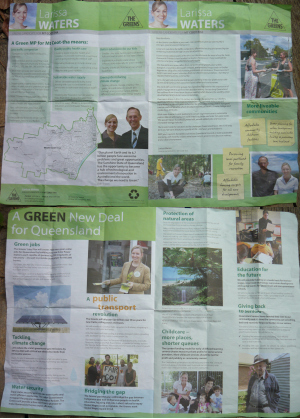
brochure for Mount Coot-tha electors
- a wasted opportunity.
Some parts of the brochure do show promise. It rightly promises to end the property resumptions for the building of the Hale Street Bridge and Northern Link tunnel white elephants and it decries the "rampant urban growth, poor public transport, and crowded public transport". Taken overall, the brochure disappoints, however, especially given the potential use that could have been made of its massive folded double-sided A2 size.
Reading this brochure, one could be forgiven for not realising the scale of the world's ecological crisis, to which Queensland's own state Labor Government has contributed more than its fair share.
No specific mention of Queensland's greatest ecological crime, that is, its record level of climate-changing coal exports, is to be found. Little is to be found about many of the issues I have raised in this document: the outrage of the anti-democratic forced local government amalgamations enacted by Mount Coot-tha's sitting member who was Minister for local government at the time, and the almost innumerable other instances of the Queensland government trampling upon the rights of local communities.
Nothing is said of the scandalous ongoing sell-off of public assets.
Whilst a small part of the brochure rightly argues for the protection of some of Queensland's natural wilderness areas, it gives the reader only the barest clue of the terrible scale of environmental vandalism being inflicted upon this state by the Bligh Government.
Above all, the brochure neglects to specifically mention the population growth encouraged by the Queensland Government, as mentioned above. This population growth is the principle driver of the "rampant urban growth" of which it rightly complains. The brochure further neglects to point out that population growth, in combination with an almost complete lack of any worthwhile town planning or effective decentralisation on the part of the Queensland government, has made necessary massive expenditure on transport infrastructure, whether it be the most inappropriate public roads, tollway roads, toll bridges or toll tunnels or the more appropriate public transport.
Instead of raising the alarm about the environmental calamity that threatens us all, and expressing the sense of outrage that many of us feel at Anna Bligh's gross misgovernment of this state, the brochure appears to convey an impression that all will be fixed, even as Queensland's population continues to climb, by the spending of a bit more money on public transport, rainwater tanks, free solar panels to pensioners, and the creation of 7,600 'green collar' jobs entailed in the construction of two new Solar Power stations.
In reality, even the full achievement of all of the Greens' campaign promises would only be scratching the surface of the serious problems we face. Indeed one Green policy, mentioned on the brochure, that is, its support for water recycling -- rightly rejected by the Toowoomba community at a referendum in 2006 -- would only make matters worse.
I was a member of the Greens party back in 2003. I joined it, whilst working in Canberra, hoping to help stop the threatened invasion of Iraq. I have a great deal of admiration and respect for many of the Greens Parliamentary representatives, as well as many rank and file Greens. Nevertheless, the Greens campaign literature, as discussed above, further confirms my impression the Queensland Greens, overall, lack the vision necessary to make their organisation a truly effective force for good in Queensland politics.
If you are a Greens supporter, but agree with my concerns about the Greens, then I believe your best chance to make the Greens lift their game is to give your primary vote to me or to other independent candidates who stand for similar policies and then to give your second preference to the Greens. (In fact, that is how I intend to vote myself.) Of course, I also urge you to take full advantage of the preferential voting system and to consider careful whether any worthwhile differences between the two major parties exist and, if so, order your preferences accordingly.
To intending Liberal National Party voters:
Throughout my voting life my own preference has been against the major conservative political parties. Whilst that hasn't changed fundamentally in 2009, I, nevertheless, find myself in strong agreement with a number of the policies of the Liberal National Party against those of the ruling Labor Party. These include its policy to offer Queensland communities which so desire an opportunity to de-amalgamate their local governments, its opposition to the Traveston Dam, and its opposition to coal mining in the Felton Valley.
I understand why many in Queensland, appalled by the incompetence and the autocratic governing style of the ruling Labor party, would see its replacement by a Liberal National Party Government as a solution to Queensland's ills.
However, it is apparent to me that on on many critical issues the Liberal National Party (LNP) is no different to the Labor Party and on some questions it is worse.
The LNP, together with the Labor Government has supported the population growth which, as raised above, has caused much of Queensland's serious social, environmental, economic and fiscal problems. Both have supported the ongoing fire-sales of publicly owned assets and both appear to be committed primarily to the private motor vehicle as the answer to our transport needs. Above all, both are recipients of massive donations from private corporations, especially property developers. For these reasons, in the longer term, a Liberal National state government cannot be expected, any more than the Labor Government, to put the interests of ordinary Queenslanders above the needs of their corporate benefactors.
Recently, Lawrence Springborg gave a hint that he may be planning to sell off more publicly owned assets when he announced that he would set up a fund to new Queensland Fund "to manage the proceeds of any sell-offs".14
Of course, the Queensland Labor Party's own record and the appalling record of the neighbouring NSW Labor Government on privatisation offers no guarantee against further privatisations. By attempting to privatise NSW's electricity generators, the NSW Labor Government went against the wishes of at least 79% of the NSW public and against an overwhelming vote against privatisation at the state Labor Party conference in May 2008 and against commitments not to privatise made prior to the 2007 elections.
Laurence Springborg's plans to 'save' $1billion by not replacing staff as they leave the public sector could add significantly to unemployment in the midst of our current recession. As Queensland Public Sector Union (QPSU) president Alex Scott, who met with Lawrence Springborg, pointed out:
"What he said is he's confirmed every permanent public servant won't get sacked as a result of the change of Government, but every time someone retires or resigns they won't be replaced so that means there'll be a cut of 12,000 jobs next year.
"That means that there'll be 12,000 more unemployed Queenslanders that could have been working in the public sector."15
Whilst on some environmental questions the Liberal National Party is better than Labor on others they are worse. An example of the latter is the Opposition's support for the environmentally atrocious shale oil project, which the Bligh Government blocked after facing a massive community protest campaign. Another is its support for Uranium mining, which the Labor Government still rightly opposes.
So the election of a Liberal National Party Government may still actually make matters worse, and not better in the longer term.
Nevertheless, if you are resolved to vote for the LNP, but want something better of an LNP government than we are likely to get based upon past experience, please still consider giving your primary vote to me.
What you can do
Above all, inform yourself and others about the issues I have raised in this article and discuss them with.
If you would like to help me in any way in this campaign, for example by handing out leaflets on the streets or by giving a few to friends please get in touch, through our contact form or by phoning 0412 319669.
Please visit our website, make comments, or, if you have a story, which you believe may be of interest to other electors, contribute an article.
Make links back to our site from your own web site, if you have one, on public forums or in e-mails.
Footnotes
1. ↑ "Cate Molloy: Traveston chosen because 'the people in the valley were all Nationals'" of 6 Feb 07
2. ↑ On this one issue, at least, I am almost in complete agreement with Opposition leader Lawrence Springborg. See also "Springborg's de-amalgamation plan" in the Government News of 4 Sep 08.
3. ↑ Tabling of Air Assets (Restructuring and Disposal) Bill on 26 August 2008 at www.parliament.qld.gov.au/view/legislativeassembly/tableOffice/documents/HALnks/080826/AirportAssets.pdf.
7. ↑ The SGIO had been partially privatised by the Borbidge Liberal and National Party coalition government. During the 1998 election campaign, Labor Opposition leader Peter Beattie, promised to retain half government-ownership of the SGIO, but broke that promise upon winning government.
8. ↑ This personally affected me. From 1996 until 1998, worked for the Warwick TAFE college to build a community Internet Service Provider, Flexi Net. After the TAFE IT services were outsourced to Unisys, a sham inquiry was conducted into Flexi Net by a Unisys consultant. Submissions from the local community overwhelmingly in support of TAFE's ISP were ignored and a recommendation to sell the ISP to a local consortium, the Warwick Business Association, was made. I worked for the new consortium. In August 1998, barely three months after he succeeded in transferring the ISP to its new physical location in the Warwick Town Hall, I was sacked, without receiving a written reference, by Peter Darton, the appointed technical manager of the ISP and Garry Hansford the business manager. Peter Darton now owns Warwick Computer Service.
In 2001, a previous employee worked of the Southern Queensland Institute of TAFE (SQIT), advised me that people high in the management of SQIT, which encompassed the Warwick TAFE college, wanted to expand Flexi Net to other Southern Queensland TAFE colleges. The source said that this plan was initially defeated by politics within SQIT and never saw the light because of Unisys. If Flexi Net had expanded, SQIT, with its large existing internal computer network, could well have been the ISP for rural southern Queensland. Instead, Flexi Net has long since been on-sold to Ipswich City Council's HaleNet, which was bought out by a Victorian ISP.
9. ↑ See quarterly summaries as pdf documents on "Australian Demographic Statistics" page on Qld Government web site at www.oesr.qld.gov.au/queensland-by-theme/demography/briefs/aust-demographic-stats/index.shtml and Australian Historical Population Statistics, 2008 and "Australian Historical Population Statistics" downloadable for the Australian Bureau of Statistics.
10. ↑ "Private fix for surgery" (unable to find URL) in the Courier Mail of 4 Mar 09. The words in this report were, "Ms. Bligh dismissed suggestions the move was a concession the current public system could not cope, saying demand had had surged because of population growth". The story reported Anna Bligh's election promise for the state Government to use private hospitals to provide 20,000 hospital patients with elective surgery over the next three years.
11. ↑Qld govt rejects population cap in the Age of 22 April 07. Also cited in "How to end the Queensland economy's addiction to population growth?" of 26 Apr 09.
12. ↑This incident was written of in "Overloading Australia" (2008), p91 by Mark O'Connor and William Lines. (RRP AU$20)
13. ↑"Output of coal to triple by 2030" by Gabrielle Dunlevy in the Courier Mail of 10 July 08, "Qld coal production to triple" also by Gabrielle Dunlevy in the Age of 9 Jul 08, A report "Qld coal exports to double to 370m tonnes by 2030" in the Australian of 9 Jul 08 reported, as the title suggests, that Anna Bligh intended 'only' to double, rather than triple coal exports by 2030. Whatever her actual plans, the consequences of such increases in Queensland's already record rate of coal extraction and export hardly bear thinking about. See also "Anna Bligh pushes coal as Kevin Rudd faces the consequences" in the Australian 16 Jul 08
14. ↑ "Lawrence Springborg announces $1bn in expenditure cuts" in the Australian of 3 Mar 09.
15. ↑ "Springborg to unveil election pledge funding" on the ABC news of 3 Mar 09.
Stonington Council goes to Ombudsman over failure of democracy in Victoria
Brumby downsizes democracy upsizes development
About a month ago Brumby gave Madden new call-in powers with the excuse that development was held up because of people - you know - citizens, voters - and democratic local councils. So under the excuse of "getting the economy going" Madden was given these extra powers.
Irresponsible authority
The very next week he intervened in the Victorian Civil and Administrative Tribunal (VCAT) over a bike track through Willesmere Park in Kew. Now that is really good for job creation!!!
Then last week he declared himself the Responsible Authority for 2 days and approved a development in South Yarra, where the developer was going against the approved plans and the council stopped it. So the developer went to Madden complaining and Madden approved it.
Developers Run to Mama Madden
The developers can now run to Mama Madden and she will wave a magic wand and make democracy disappear. It is rumoured that that Madden sees councils as getting in his way, basically.
Citizens appeal to omsbudsman
Today candobetter received information that Stonnington Council are appealing to the Ombudsman about the arbitrary call-in by Madden when the developers went knocking on his door.
The Ministers action will now be tested and the result will have bearing on all our futures.
If the Omsbudsman cannot stand up to the government on this issue of democracy then it is really time for a review of all our laws.
Remember solidarity?
Let all the people in all the states stand together in solidarity against the developers' overweaning demands, remembering that is was the growth lobby's demand for population growth to create demand for housing and the finance sector's exploitation of this undemocratic, unstable and anti-social market through sub-primes and various unreasonable fees and hidden cuts, that brought, not just Australia, but the world into the current depression.
Victoria's dinosaur economy - big projects, big debts, big talk
Mr Madden is acting for a dinosaur economy that is completely unsustainable and contributing frighteningly to overpopulation, greenhouse gas emissions and reduction in biodiversity and freedom for citizens. He should be made an example of for other arrogant state ministers to heed and reform before we lose even more of our natural ammenity and quality of life for nothing more than inflation to line the pockets of parasitic developers and their finance jockeys.
Recsei says high density causes more problems, fixes none
Dr Tony Recsei, President of SOS Sydney has written to the SM Herald about the fact that there is no high density city in the world not suffering from the problems that high density is supposed to prevent. He states that local research shows when you have high density you get increased traffic congestion, longer travel times, more energy per person used, no saving of water, increased housing costs and housing choice reduced. This retrofitting high density onto areas designed for low density does not save on infrastructure costs, it just overloads infrastructure and is much more expensive to fix than putting in new infrastructure in new areas.
Public Alert - ADI Site - Council to approve 3420 houses Monday night
(Comment available on the following topic - Geoff Brown 0431 222602)
Residents everywhere need to support each other against giant development companies
Penrith Council is set to vote tomorrow night to approve 2 new suburbs totalling 3420 dwellings at the former ADI Site. Council planners are urging councillors to approve the plans.
Residents that have fought a 16 year campaign against the development of property giant Delfin Lend Lease are calling on councillors to defer approval due to the general public having no idea what is going on. Councillors are being asked to hold a series of public meetings so that fair dinkum community consulation takes place
.
There are multiple problems with the development ranging from environmental, bushfire, traffic, noise, access, provision of parkland. Essentially this development looks like a disaster to us.
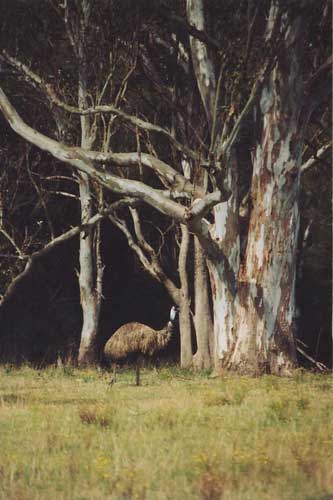
Council overshadowed by authoritarian State planners
Council cannot amend or reject the development plans of Delfin without first getting the approval of Planning Minister Kristina Keneally. They must be seen to be advocating on behalf of the public and take this planning mess back to Kristina Keneally. The NSW gov allowed most of the problems with pro developer zonings suggested by Delfin.
Councils report outlining amongst other things the issues raised by public and Government Dept submissions can be found here http://203.221.255.19/pccbps/Open/2009/PRC_09032009_AGN_AT_WEB.HTM
You may note want to look at comments about DECC's submission. They have raised concerns about development close to bushland. They are also trying to get out of managing wetlands (featured heavily in the Daily Telegraph) zoned Regional Park by Frank Sartor.
Below are just some of the issues that we notified local residents about this weekend when letterboxing
· 3420 dwellings with apartments up to 8 storeys (PCC 2008 Report) high ruining our landscape. Building blocks as small as 125sq/metres with tiny setbacks
· 10,000 residents meaning 5000 more cars on our choked roads
· 362 hectares of land will be cleared which is largely endangered Cumberland Plain Woodland. Sensitive wetlands home to endangered waterbirds to be surrounded by housing
· The fracturing of a biodiversity corridor which currently links ADI to bushland north of the site. Housing will fracture the existing corridor
· Delfins tree survey identifies a staggering 20,000 trees within the development areas that may potentially be removed
· The entire development is classified as a bushfire prone area
· The Central Precinct is another Glenmore Park and the only access is by one east west road which will cut through the 900 ha bushland area. This is poor planning resulting in a public health and safety issue.
· Bushfire Asset Protection Zones of only 25 metres
· The obliteration of the Northern Rd bushland view
· 4 new roads entering off the Northern Rd
· Housing will surround Xavier College and there will be a road behind it
· Delfin need to provide 19.46 ha of public parkland in the Western Precinct yet they are only offering 15.63. This means Council is allowing them to rip off the public and profit from developing this extra land
· The list goes on and on. More info at www.adisite.org
There is still time for Council to fix up this planning mess. Call your local Councillors to demand a public meeting and urge them to defer their decision until they have fixed up the development plans of Delfin Lend Lease. Attend the Council meeting this Monday night at 7pm
Clr Kathryn Presdee 0418 288488, Clr John Thain 0411 427812, Clr Ross Fowler 0419 738484, Clr Ben Goldfinch 0401 678509, Clr Kevin Crameri 0401 995 825, Clr Jim Aitken 0418 288488, Clr Greg Davies 0419 177259, Clr Jackie Greenow 96232366, Clr Mark Davies 0416 085597, Clr Tanya Davies 0421 600 025, Clr Prue Guillaume 0401 678520, Clr Karyn McKeown 0401 995945, Clr Kaylene Allison 0401 995843, Clr Marko Malkoc 0401 678512, Clr Robert Ardill 0401 678505
Dirty livestock carriers in Australian ports
Update: Federal Court bans polluting live export death ships from Australian waters.
Originally published 23 Feb 09.

The Australian Maritime Safety Authority (AMSA) is responsible for ensuring that all ships in Australian ports comply with s 6.6 of Appendix 4 of Marine Orders Pt 43, which required an effluent treatment plant or holding tank to be part of the vessel. In September 2008, AMSA issued orders under that section to prevent the 28 year old converted car transporter "Al Messilah" from proceeding from Fremantle to Portland to load a cargo of 72,000 sheep.

Rural Export and Trading (WA) Pty Ltd contested the order in the Federal Court on October 3 2008. Amongst its arguments were that this was a discriminatory action against foreign-flagged livestock carriers. RETWA operates the (even older) "Al Kuwait", and the 23 year old "Al Shuwaikh", (all Kuwaiti registered) and also is understood to use the 30 year old ex-car transporter "Merino (aka Cormo) Express", registered in the Philippines.
It should be noted that there are no livestock carriers registered (flagged) in Australia; all, without exception, sail under "flags of convenience" such as Panama, obscure Caribbean nations and the Philippines, where requirements are far less stringent. The crews are from third world countries, and Hansard reports indicate that they are vessels of choice for crews "jumping ship".
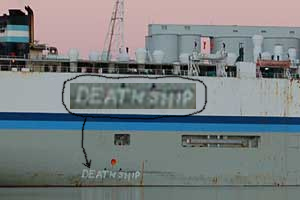
The "Al Messilah" is particularly noteworthy because of its voyage from Devonport in February 2006, when 1,683 of the 71,309 sheep on board died during the marathon 24 day journey to four Middle Eastern ports. It was met with a storm of protest in Devonport, where animal advocates painted, quite aptly as it turned out, "Death Ship" on its hull. Advocates also attempted to block the ship's entry in the Devonport channel with kayaks and zodiacs.
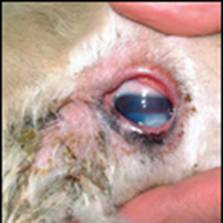
The mortality report pointed to Tasmanian sheep being poorly adapted to lengthy, cross-equatorial journeys, the outbreak of a disease (keratoconjunctivitis, or pink-eye) which had first presented at the feedlot prior to loading, the animals not being in the feedlot for the mandated period, and "inanition" (a euphemism for starvation), partly because insufficient fodder had been loaded for the journey. One report suggested that the exporter had expected a higher mortality rate and had deliberately loaded insufficient feed.
The "Al Messilah" was also investigated in 2002 when 2,173 of the 74,985 sheep on board died (report available at www.liveexportshame.com). The "Al Shuwaikh was investigated for two successive voyages in 2002 (20 and V21), when 5,800 and 2,304 sheep died respectively. It was allowed to load again before the reports were completed, and a further 1,000 sheep died on that voyage. The "Merino (aka Cormo) Express" is legendary for its mortalities.
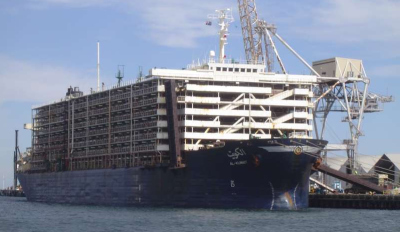
A FOI request to AMSA to elicit the name of the ship in question at the time resulted in a request for payment for this information, and it was sourced from the Federal Court (Austlii) database. Such information should be a matter of public record.
AMSA returned the matter to the Federal Court court in February 2009, before Dowsett, Rares and Gilmour JJ. The transcript indicates that the "Al Messilah" has sufficient pollution equipment to deal with the effluent from the approximately 50 crew if carries - but NOTHING to deal with the effluent from the approximately 80,000 animals it can carry. The judges concluded that Siopsis J, the judge who heard the matter on October 3 2008, had erred in his judgment of October 2008, and AMSA's appeal be allowed, with costs.
The "Al Kuwait" and "Al Shuwaikh" are substantially larger, but are not mentioned in the court transcript.
Given that these ships. and possibly others, are dealing with effluent from upwards of 100,000 animals, what will AMSA do the next time one of these ships attempts to load animals in Australian ports? Each has entered and left Australian ports any number of times since last October.
See also: www.liveexportshame.com, Stop Tasmanian Animal Cruelty at www.stoptac.org.
Topic:
Institutionalised cruelty to lab-chimps in USA exposed by US Humane Society
Introduction:
I find it incongruous - to say the least - to think that the humans are sitting in armchairs watching t.v., driving cars, eating with their partners and children, leading affluent lives on the basis of earnings from the industrialised depravity - nazi-like in its cleanly-institutional style - we see in the video.
Go on, have a look; it's not that kind of video

original photo by Michael Nichols at http://animals.nationalgeographic.com/staticfiles/NGS/Shared/StaticFiles/animals/images/primary/chimp-peeking-through-leaves.jpg
But it's also nothing like the photograph above of a young chimpanzee free in his natural surroundings.
The video does not contain intentional torture. It shows many chimpanzees and monkeys in bare cages with concrete floors, who are kept there for many many years. They are powerless and frightened. Baby chimps are bred there and taken from their mothers for experiments. You don't see the experiments, but you do see the animals restrained and a baby chimp crying as blood is being taken from it or it is being given a drug. You also see animals thrown roughly down on hard operating tables. Most of all you see a great deal of barren cleanliness with living creatures confined like criminals in tiny cells as masked and gowned staff go about 'just following orders' no doubt. One chimp was taken from the wild 25 years ago and has lived in concrete cells since then, apparently.
This situation is a reflection of the hardness of US society where keeping a job requires uncritical subservience. It also reflects the kind of ignorance that many people thought had disappeared with the Victorian era of tiny zoo-cages, or because we have all become 'civilised' in the western world, due to ... ahem... human 'progress'...
Political engagement against dystopia
But, yes, we do live in a world where this is going on all the time for other animals for food production, and the US has something like 7 million human beings confined in prison cells as well. But being surrounded by industrialised cruelty is not an excuse to give up. It is all the more reason to protest - because not to do so depraves us all. When we are all depraved, accepting this as normal, then there is no hope and we have all become part of the machine.
How to register your disgust
Here is a link to a form you can fill in to send automatically to US legislators if you live in the US. Alternatively, you could just look up your US embassy and send them an email with a copy to the US Humane Society, at this email address: humanesociety[AT]hsus.org. I sent a copy of this article to the Melbourne-based US embassy. You might also email a copy to the NIRC itself: NIRCadmin[AT]louisiana.edu
Anyone associated with this research, especially those in charge of it, in my opinion, should be stripped of their assets gained through such unacceptably callous exploitation. We need names and faces to pin to these atrocities. Anonymity is what keeps such practices going.
It would be much harder to condemn the New Iberia Research Center (NIRC) in Louisiana if the institution had obviously made a great effort to compensate these animals by giving them trees and a lovely environment between 'sessions'. But they have confined these forest creatures to an environment as friendly as a toilet block for life.
What sort of rectal human phenomena would do such a thing? I simply do not know, but I guess someone emotionally dead and fixated on material survival. Or perhaps someone who actually believes that non-humans have no feelings or worth. Unfortunately a lot of humans have become like that and the rest of us have to try to fix up the damage they do everywhere.
The story is from the Humane Society of the United States, which has a lot more clout than the Australian RSPCA. Supporting them will probably lead to a real improvement in this problem.
Story accompanying the video (informative, not schlocking)
A nine-month-long undercover investigation by The HSUS has exposed the mistreatment of nearly 300 chimpanzees and other primates at the New Iberia Research Center (NIRC) in Louisiana. These chimps, living lives of deprivation and misery, are among the more than 1,000 chimps languishing in laboratories across the United States. Chimps, our closet genetic relative, are complex, social, and long-lived creatures. Many chimps currently warehoused in research facilities have lived for decades behind bars. Especially heartbreaking are stories of the 26 elder chimps at NIRC, who were taken from their mothers in the wild.
The Great Ape Protection Act (H.R. 1326) has just been re-introduced in Congress. This legislation aims to end invasive research on the chimpanzees remaining in laboratories, retire the approximately 500 federally-owned chimpanzees to permanent sanctuary (including the elder chimps at NIRC), and make the recent decision by the National Center for Research Resources (part of the National Institutes of Health) to stop funding the breeding of federally-owned chimpanzees permanent.
The United States is the only country, besides Gabon, that still uses chimpanzees in invasive research. The United Kingdom, Japan, Sweden, Australia, New Zealand, Austria, the Netherlands, Belgium, and Spain have all banned or severely restricted the use of chimpanzees. Please help the U.S. join this list of nations by co-sponsoring The Great Ape Protection Act.
Something else you can do - sponsor a chimp via the Jane Goodall program!
The Jane Goodall Institute of Australia has launched a Guardian Program where you are able to:
* become a caretaker of a chimpanzee, an orangutan or a gorilla;
* support the Lwiro Sanctuary in Congo;
* assist their tree planting efforts in Tanzania.
That is a good idea and we need it for koalas and kangaroos (among other victims of human expansion) in Australia as well.
Kyogle residents fight World Rally motor race
Contents: A Kyogle district resident states the case against the motor race, The Repco FIA World Championship Rally is More Than a Koala can Bear, How the Kyogle District Chamber of Commerce, Rally Australia and the Kyogle Council imposed the motor race on local residents.
Residents of the Kyogle district of NSW, just south of the Queensland border, are organising to protect their way of life and local wildlife from the threat of an FIA (Fédération Internationale de l'Automobile) World Rally motor race scheduled to be held in September 2009.
A Kyogle district resident states the case against the motor race
The following letter sent, recently to the Tweed Echo by Kyogle district resident Kathryn Kermode, states the priciple objections to the holding of the Repco FIA World Championship Rally in the area.
Gary Connelly from Repco Rally Australia seems to be surprised that many residents along the proposed route of his event are not welcoming him warmly. We await Dr Steven Phillips environmental report with great interest, to see how Rally Australia will demonstrate protection of our threatened species, but this report will not address all of our serious concerns.
Noise. We are residents of a quiet country road. We want to attract tourists to our road who appreciate the natural virtues and who have the time to stop and look at the view. Noise is not a new problem for the WRC (World Rally Championship), reading the Irish press reports it appears that the residents in Drumkeerin have summoned the organizers of the WRC to court over the noise. They say "the previous rally held in November 2007 was held with total disregard for residents, their property and safety, and that the noise leading up to it caused total sleep deprivation and the "terrible" noise of the rally itself left animals and a disabled person traumatised."
Lack of Consultation. The public community meetings, that were stacked with outsiders by the organisers, have not answered the serious concerns raised by the residents. Repco Rally Australia has however successfully and derisively, divided our community and marginalized the residents. It is a great shame that Events NSW who have handed over our taxpayers dollars did not consider the region and undertake a feasibility study prior to the event being placed in Northern NSW. It seems the process of decision-making has been rushed and the event is being pushed through without true consultation and consideration of the community living along the stages.
Dangerous Copy Cats. The WRC is a dangerous sporting event. Drivers, co-drivers and spectators have been killed during the WRC; Repco Rally Australia will be working hard to try to ensure this will not happen in our region. They cannot however promise that there will not be a fatal accident and will have helicopters on site ready to airlift the wounded to hospital if necessary. Have Repco Rally Australia considered that the residents do not want anyone dying at our mailboxes? In fact, many residents do not want a high speed, long-term activity on our roads. Existing research indicates a link between motor racing and road accidents. Accident rates can be higher in localities that have been associated with a motor racing event, casualty accident rates on the public roads around Melbourne's Albert Park significantly increased when the public roads were used as a Formula One race circuit.
The majority of people attending the WRC are young males, a category already over represented in our region as road statistics. This is not a family fun event, we are asking the wider community to fully consider the repercussions to our young drivers if nothing else.
Pollution and Resources. Rally Australia's carbon offsetting will not reduce the level of pollution that the residents who live on the route will be forced to endure. All the dust, fumes, noise and the potential for fire that is created by a high speed motor sporting event of this scale.
Liberty and Amenity. Repco Rally Australia is removing our civil liberty and amenity. They are restricting and removing access to our properties and the public roads that we pay our council rates money to upkeep.
The Cost. NSW taxpayers are footing the bill for the event. Would you as a taxpayer rather the millions be spent on hospitals and education, or do you see this event, which has a non-viable record of accomplishment as a good choice for the NSW Government. The amount of money that Events NSW has provided Repco Rally Australia with, should be disclosed and accounted for.
Community Aspiration. Our community wants to collectively lighten our footprint on the earth. We aspires towards principles of the organic industry; home grown, hand made, slow food, bird watching, bush walking, recycling and rainforest restoration are activities that we want to embrace and encourage for our region. We would like to see the local B & B's full every weekend, we would like to see the verandahs in the village eateries bustling with customers every weekend, not overflowing and unable to cope once every second year.
The WRC will benefit a few financially in the short term, but it will carry a huge burden of cost for the residents in the long term.
Kathryn Kermode
Sargents Road
See also: "Tweed Shire Council General Manager, Director of World Rally Australia?" of 8 Apr 09, "World Rally is too noisy say residents" in the Sligo Champion of 19 Nov 08, "Damaged bridge 'won't impact on rally'" in the Leitrim Observer of 16 Jan 09, "Failure in bid to divert rally" in the Irish Independent of 11 Dec 08, "Noise pollution case against Rally Ireland dismissed" of 19 Dec 08,
"World Youth Day wash up" of 5 Feb 09 about how the supposedly cash-strapped NSW government, which is subsidising the rally in Northern NSW, squandered AU$120 million on World Youth Day last year.
The Repco FIA World Championship Rally is More Than a Koala can Bear
The following letter was published in the community newspaper Northern Rivers Talking Turkey on 25 Feb 09.
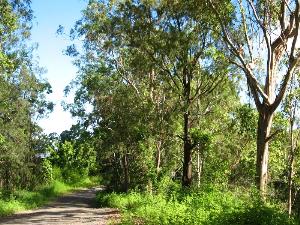
If the dumb animals could speak I wonder what they would say, would they ask for justice or compensation? The day after Rally Australia walking into Kyogle and divided the community with its fun map, I filmed Sargent the koala, about three meters from the ground in a grey gum, right beside Sargents Road.
Sargents Road has a known koala population, it is quite possibly a koala corridor as it is lined with schedule 2, koala feed tree species, it could even be core koala habitat. Why then would Kyogle Council and Rally Australia even consider it as a good option for their race map?
I ask Kyogle Council and Rally Australia, if Sargent the koala happens to be up in his tree, or any other tree, during the reconnaissance exercises or the race what will Gary Connelly and his troupe of volunteers do? Will they
a) Ignore the fact that there are koalas in the trees and race their cars up
to 200 kph
b) Poke it with a stick, throw things at it or try other methods to scare it
away.
c) Knock it out of the tree, catch it and take it away.
There is already a plan in place, it has been created by the Department of Environment and Climate Change (DECC) to ensure the survival of the koala in the wild and it is called the Recovery Plan for the Koala, published November 2008. It would be wise for Kyogle Council to recognize this and the value that koalas have for our Community, both in terms of their presence in our landscape but also their unfulfilled potential to attract the tourist dollar.
It would be foolish of Rally Australia to ignore our plea to protect our koala. We must as a Community realize that we need to protect our wild populations of koalas NOW. This iconic species is declining in nature, and is fast headed toward the Endangered List. We ask Rally Australia to think of the future. We cannot buy back the species once we have pushed it to the brink; it is not like offsetting carbon emissions.
One intelligent choice remains for all those involved: The World Rally Championship should immediately be re-routed away from koala habitat.
Kathryn Kermode
Sargents Road
Cawongla
How the Kyogle District Chamber of Commerce, Rally Australia and the Kyogle Council imposed the motor race on local residents
This was orignally published in a Kyogle District local newspaper wiht the title "Kyogle Rallying ..."

Rally Australia sponsor a website where they post Public Relations Statements (e.g. "Community Support, Economic Benefit And Green Policy Refute Rally Australia Critics"). These statements are sent out to the Media as Media Releases for Journalists who are obliged to rehash them into news items. One of their most recent stories is about Kyogle's District Chamber of Commerce giving their support, in principle, to the Rally. Rally Organisers asked pro-rally supporters to make their voices heard in the community, in the media, everywhere in order to drown out the voice of those against the rally but it is not the role of big business to attempt to divide our community through blatant lobbying. The most memorable demonstration of this divisive behavior was Rally Australia's stacking of February's Community Consultation meeting. In a very embarrassing slip up, Gary Upson from Rally Australia accidentally sent an email intended for Arthur Piggott, Kyogle Council's General Manager, to one of the rally's opponents. In it, Gary Upson asked Arthur if he could get as many of his pro-rally supporters to the meeting and suggested that he would do the same from within the rally fraternity. Well, sure enough, that meeting had people from the Rally Fraternity coming all the way from Brisbane. This debacle also reveals a possible politicisation of Kyogle Council's administrative staff, risky business given Council's previous track record. And by the way, who exactly requested a Police presence at the meeting? Is NSW Police also to be co-opted to the pro-rally agenda?
Where can Rally opponents turn when their own Council no longer represents their best interests but represents primarily the interests of a Client who will soon have a Development Application pending? I would argue that Rally Australia has a Public Relations strategy with malicious intent. I would also argue that Kyogle Council doesn't have the planning policies to even consider the World Rally Championship's Development Application. What have we got to lose if this project proposal is gone over with a fine toothed comb by a panel with expertise in all the issues it raises?
On Rally Australia's website, Kyogle Chamber of Commerce President, Councillor and Businesswoman, Ms Lynette Zito, claimed quite ingenuously, that the Chamber "did not ask the proposed rally to come here, but now that they are looking to hold this international event in our location we are looking at what we want to make of it." The reason the Chamber didn't invite the Rally may have something to do with the idea that it wasn't the kind of Sustainable business opportunity they were looking for. After fourteen separate workshops with community members in the preparation of Kyogle Council's Sense of Place Economic Statement, it was concluded that throughout "the consultation process the community has echoed a range of common desires. Whilst most recognize the need for economic development and growth, they fear the loss of their way of life and core cultural elements that build a sense of ownership and pride in their community." Too right they do!

The people of Kyogle collectively identified the "environment, its protection and enhancement [as] a priority to the community as it is the reason why people chose this place to live." The statement revealed that the residents who attended the Council's workshops felt the Environment was critical to the growth of tourism in the area and was in fact its greatest attraction. So yes, why would these people invite a Motor Sporting event into the community? The truth is that it seemed nobody invited it except a few people who had discussed the issue with Kyogle Ex- Mayor Ernie Bennett. He met with the World Rally Championship organizers in mid April 2008. At the Ordinary Council Meeting of April 21, an urgent motion to approve the Rally in principle was passed without further discussion. At the next Ordinary Council Meeting after that, in May, likewise, there was no further discussion. There have been no Feasibility Studies or Council Environmental Studies so I ask: How do we know the Rally will be good for our Town? Did Mr Bennett know something more and did he pass the Arcane knowledge of such onto the new Mayor Mr Brown? That rushed and undebated urgent Motion was all that was needed for this Rally's Organisers to come speeding into our lives telling us what we should and should not be doing for the Rally and what is and isn't good for our Economy and our future. I hope the lesson of this is that more of us become involved in Local Council.
Kyogle Council's Sense of Place Economic Statement placed great importance on the values and guiding principles that emerged from the Consultative Meetings it initiated saying that they articulated "those fundamental and common rules that should be applied in the planning and implementation of all future projects." That statement seems like a hollow one now. I believe the common thought about the Rally among Pro-rally supporters is that, like Lynette implies, it just fell into our lap and we should all make the most of it. We can't build an envisioned Sustainable Tourism Industry in such an undisciplined manner. We are sending mixed messages to those we previously encouraged, investors with Eco Tourism, Green and Organic Agriculture and Farm Gate to Plate projects, to name a few. Kyogle must be pro-active in determining its way forward without losing the unique identity of being Gateway to the World Heritage Gondwana Rainforests as well as a Gateway for its children into a reinvented 21st Century Rural Heartland.
Motor Sports is an incompatible Eco activity, it is largely irrelevant to the Agricultural Industry and it can only undermine the very World Heritage Environmental values Kyogle's residents so obviously value. Our young men don't need any more encouragement to find out the hard way that speed kills. Even being a spectator at a Motor Sports event is a dangerous activity and one which the World Rally Championship Organisers refuse to underwrite with any moral responsibility. Before you even think about where you're going to find a park to watch the race from, I invite you to peruse this Confederation of Motor Sports' Indemnity clause for potential spectators to September's World Rally Championship. Would you sign it?
Jenny Bluefields
Form to indemnify rally orgnisers from legal liability arising from injury
Repco Rally Australia Tour: September 2-7, 2009.
Disclaimer
Exclusion of liability, release and assumption of risk motor sport is dangerous
In exchange for being able to attend or participate in the event, you agree:
to release Confederation of Australian Motor Sport Ltd ("CAMS") and Australian Motor Sport Commission Ltd, promoters, sponsor organisations, land owners and lessees, organizers of the event, their respective servants, officials, representatives and agents including Rally Sport Magazine and Rally Australia Pty Ltd (collectively, the "Associated Entities") from all liability for your death, personal injury (including burns), psychological trauma, loss or damage (including property damage) ("harm") howsoever arising from your participation in or attendance at the event, except to the extent prohibited by law;
that CAMS and the Associated Entities do not make any warranty, implied or express, that the event services will be provided with due care and skill or that any materials provided in connection with the services will be fit for the purpose for which they are supplied; and
to attend or participate in the event at your own risk.
You acknowledge that:
the risks associated with attending or participating in the event include the risk that you may suffer harm as a result of:
motor vehicles (or parts of them) colliding with other motor vehicles, persons or property;
acts of violence and other harmful acts (whether intentional or inadvertent) committed by persons attending or participating in the event; and
the failure or unsuitability of facilities (including grand-stands, fences and guard rails) to ensure the safety of persons or property at the event. motor sport is dangerous and that accidents causing harm can and do happen and may happen to you.
You accept the conditions of, and acknowledge the risks arising from, attending or participating in the event and being provided with the event services by CAMS and the Associated Entities.
Signed……………………………………………………………. Date ……………..
GDP per person falls in every state of Australia because of population growth
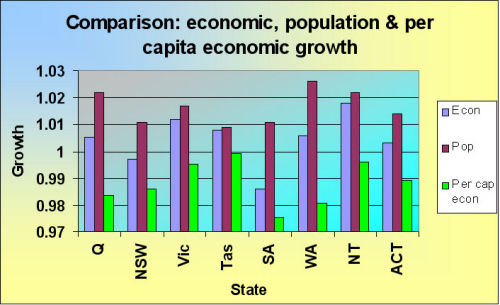
Despite figures showing economic growth in some states, per capita GDP has fallen in every state in Australia, according to Sustainable Population Australia Inc (SPA).
Dr John Coulter, National President of SPA, says residents of those states in which gross GDP has risen have had their apparent advantage wiped away by population growth.
December quarter per capita economic decline in every state
'Most economic commentators assume that changes in GDP are proxy measures for changes in human welfare,' says Dr Coulter. 'Accepting for the moment that this is the case, then change in GDP per person, rather than gross GDP, is actually a better measure of welfare.
'If we look at per capita rather than gross GDP, then all states show negative growth for the December quarter.'
Tasmanians did better than all other states.
Dr Coulter notes that Tasmania, with the lowest rate of population growth, showed the least negative economic growth with only a 0.1% fall per capita. Western Australia, which had the highest rate of population growth, shows the second largest fall in per capita GDP at almost 2%.
'Queensland is in a similar position,' he says, 'sharing with the Northern Territory the second highest rate of population growth but having the third largest fall in per capita GDP. South Australia has the biggest drop in GDP, a high rate of population growth relative to the economy and the largest decline in per capita GDP at 2.5%.'
The figures indicate no economic or welfare advantage from a growing population
Dr Coulter says the figures indicate no economic or welfare advantage from a growing population.
'They confirm calculations I have made over many years comparing OECD countries. These calculations repeatedly show no statistically significant correlation between population growth and growth of per capita GDP. They parallel the conclusion of the Productivity Commission report which showed that, despite excluding many of the environmental costs of a larger population, there was no demonstrable link between increase in immigration and per capita economic growth.'
With respect to tackling climate change, Dr Coulter notes that the Rudd Government clearly accepts that there are considerable environmental costs from a growing population.
'In fact, there are a host of other environmental costs from population growth,' he says.
'It is long past the time for all Australian Governments to adopt population policies aimed at environmental sustainability, rather than the mirage of economic and welfare benefits from a growing population.'
For further comment or information:
Dr John Coulter 08/8388 2153
From a media release
5 March 2009
Department of Environment fails to act to save endangered Koala because of technicality
This media release with was received this morning. As an independent candidate for the seat of Mount Coot-tha, I will do my best to raise this critical issue in the remaining weeks of the campaign. If elected, I will put legislation before the Queensland Parliament to outlaw the destruction of any more Koala habitat in South East Queensland. - James Sinnamon, 5 March 2009.
Say Sorry Mr Garrett

The Australian Koala Foundation (AKF) was told yesterday that their nomination for the Southeast Queensland koala population as a critically endangered species under Federal Environment laws would not proceed because "the form had not been filled in correctly."

Despite images of burnt and desperate koalas flooding the world and on the eve of Environment Minister Peter Garrett performing with Midnight Oil this Saturday for bushfire relief - including the famous Sam the Koala - he has turned his back on the koalas that desperately need his support for the protection of habitat in Southeast Queensland.
CEO of the AKF Deborah Tabart OAM is saying Mr Garrett has lost control of his Department or worse still, does know of this decision, which would be even more disturbing.
"The ironic thing is he is the custodian of our koalas and he should be the one telling his bureaucrats to fill in the boxes - we're tired of doing the work for you, Mr Garrett.
"It is outrageous that after the AKF has poured $8 million into science proving the koala is a threatened species, they still find a loophole to avoid protecting it," Ms Tabart said.
"You have to ask, is this because of a too close relationship between political donors and the Rudd Government?
"I am convinced this situation is linked to the upcoming Queensland election and by September 2010, when the listing decision is due, all approvals for infrastructure and development will have been granted by then.
"I am shocked at the lack of compassion of the bureaucrats in Canberra who know that this bureaucratic decision will see the demise of the Southeast Queensland koala population and I want the people of the world to know.
"Our Governments are prepared to watch the Southeast Queensland population go to extinction for their own political gain," Ms Tabart said.
Even if the AKF submits another nomination, it will not be reviewed again until September 2010 despite predictions that the koala could be extinct in Southeast Queensland within just five years.
To find out ways to help the Australian Koala Foundation save our koalas, visit the website at www.savethekoala.com.

Sophia Walter
Public Relations & Communications
Australian Koala Foundation
www.savethekoala.com
GPO Box 2659 Brisbane Qld 4001
Tel: (07) 3229 7233 Fax: (07) 3221 0337
sophia [ AT ] savethekoala.com
See also: "Queensland Government killing koalas for developer dollars" of 12 Aug 09, "Wildlife also bleed, also feel, also lost their homes" of 13 Feb 09, "Development project threatens second largest Koala Colony in Tweed Shire" of 21 Feb 09.
One year later: no explanation from Queensland Health for falsified fluoridation data
Media Release from Merilyn Haines, spokesperson for Queenslanders For Safe Water , Air and Food Inc and Independent candidate for South Brisbane
One year anniversary and Qld Health ethical standards unit has still not explained falsified data
It is exactly one year now since the Crime and Misconduct Commission advised that Queensland Health would respond in "due course" in regard to evidence presented to the CMC that Queensland Health had falsified tooth decay data used by Premier Bligh to justify forced fluoridation.
When Anna Bligh announced on 5th Dec 2007 that she had made the decision that fluoridation was to be forced on Queenslanders, she used graphed data comparing tooth decay in Townsville children to Brisbane children. The data was from 1991 and showed a difference then of 2 less decayed teeth in Townsville's children compared to Brisbane children. The data was also sent to some MPs and through this access, it was discovered that Queensland Health had exaggerated tooth decay data used by changing the units from teeth surfaces to teeth. Instead of a difference of 2 baby teeth out of 28 baby teeth in a child's mouth, the difference was only 2 tooth surfaces out of 128 tooth surfaces in a child's mouth.
Queensland Health also had access to data on permanent teeth which showed very little difference , but chose to only use baby teeth data and then exaggerated that by falsely changing the units.
Queensland Health did however use some tooth decay data from permanent teeth in children when newspaper advertisements were placed across Queensland claiming that Townsville children had 65 % less tooth decay than Brisbane children, but they did not disclose that the 65% difference related to an absolute average difference of only 0.2 tooth surfaces out of 128 tooth surfaces.
Queensland Health also chose to ignore data from 2000, 2001 and 2002 which showed that Townsville children had more tooth decay than children from the North Brisbane , the Gold Coast , Wynnum, Rockhampton and several other non fluoridated areas of Queensland.
This was all explained to the Premier and the Health Minister in a meeting with them on 12 Feb 2008, but they pushed ahead and forced fluoridation on Queenslanders regardless, while changing the Legislation to remove all liability.
Over the last year repeated calls have been made for an explanation as to why Queensland Health bureaucrats exaggerated tooth decay, ignored relevant data showing no benefit, and also illegitimately dismissed evidence of the risk of Osteosarcoma bone cancer in teenage boys with water fluoridation.
Verbal advice from the Ethical Standards Unit just prior to announcement of State Election was that the Ethical Standards Unit was "almost" in a position to respond. It appears that even after a year, Queensland Health is having difficulty explaining it's actions.
Unethical forced fluoridation based on falsified and exaggerated tooth decay is one of the reasons why Merilyn Haines has nominated as an Independent candidate in South Brisbane, Anna Bligh's own seat. The issue of forcing people to drink recycled water sourced from sewage is another, as is the planned of the Royal Children's Hospital.
Contact: Merilyn Haines mobiles 0418 777 112 and 0403 029 077
See also web site of Queenslanders For Safe Water , Air and Food Inc at www.qawf.org.
NSW Planning Minister brings tragic, stupid end to last grasslands
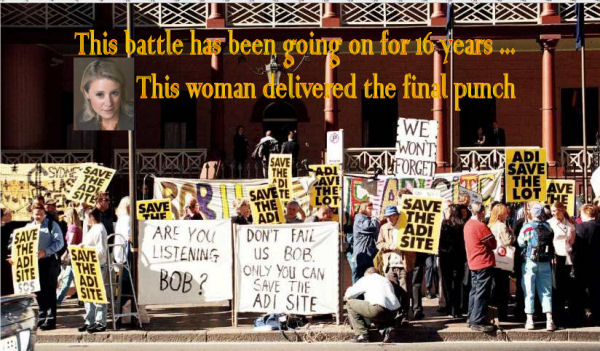
It seems that the people who have managed to get into power in this country simply cannot take seriously the importance of the natural world to climate, aesthetics, society and human survival. Money eclipses everything in their Growth Lobby paradigm, including democracy.
Today this dreadful news arrived from Geoff Brown of the ADI Residents' Action Group:
Keneally gazettes green light to Delfin Lend Lease to bury last grasslands in vast suburbs
Kristina Keneally the NSW Planning Minister on Friday gazetted amendments to the SREP 30 the zoning plan for the ADI Site. Under the NSW Environmental Planning and Assessment Act the Minister could, based on submissions received from the public, amend SREP 30 any way she saw fit. We called on her to use her planning powers to protect a further 100 ha of Cumberland Plain Woodland by rezoning land from urban to conservation (E2 Environmental Conservation was proposed - therefore no cost to government). Nearly 300 ha of regenerating bushland is zoned urban by SREP 30 and will be cleared so our proposal was a compromise in the hope that we may just get some support from the NSW Government. It would of reduced the development by 1000 dwellings = $100 million that Delfin would of lost.
As a result of Fridays gazettal of SREP 30 Penrith Council now has the green light to approve Delfin Lend Leases massive Western and Central Precinct Plans (suburbs). This equates to 3400 lots. Council planners are now rushing to prepare for next Monday night the 9th March when a Report will come before the full Council urging that they approve both plans.
Government by cynicism
We recently met with Council Planners about Delfin Lend Leases abysmal plans. Despite raising numerous issues it was obvious they just don't care. They had no valid responses to our questions. Talking to them was like talking to the developer. Q's such as 'Delfins tree survey identifies 20000 trees - will these be removed? Answer - Don't know. Q's What are you going to do about the fact Delfin have a 3.8 ha shortfall in the provision of public parkland (open space) within the Western Precinct. Answer - Delfin can use the Regional Park to cover the shortfall. Apparently only 40 comments were received on the Precinct Plans so they are cocky that there will be little public opposition from here on. Personally I am quite disappointed that such a massive ecological disaster could only attract 40 comments.
So if you are not completely over it and still have some concern then do what you can. It would be good to wind up this 16 year campaign (arguably one of the longest resident campaigns) next Monday night with a packed public capacity giving Penrith Council what they deserve.
Info on the planning disaster that Council will approve and the issues we raised with Councils Planners are here http://www.adisite.org
You may be interested to know that Blacktown Council refused to commit to the acquisition of the Norman St bushland at Prospect. Council voted unanimously. They came up with some excuse to make continued representation to State and Fed Gov'ts to obtain funding.
Simple natural solutions to fire and flood

see Candobetter review here of Peter Andrews' book on Natural Sequence Farming
By Duane Norris (Natural Sequence Farming)[1]
The present circumstances around the country pose a huge headache for Governments with devastating fires in Victoria and floods in Queensland.
Once this Australian landscape ran itself.
The fire cycle, prior Aboriginals, was once in every 300 years. Today, it is once in every 2-3 years (regardless of the cause).
Inground water and a dense cover of fire retardant, biodiverse plants once cooled the Australian landscape.
Today, our landscape is drained, dried, desiccated, barren of plant cover except for incendiaries of Eucalyptus trees waiting to vaporise like petrol tankers.
The answers to the problems we are witnessing are there for all to see...they are simple solutions. Solutions given to us by Nature and available for all to see.*
The floodwaters and fire regimes could be far better managed if only authorities understood these simple landscape processes.
The national landscape catastrophes currently facing our country need to be addressed at the highest levels including the Premier's proposed Royal Commission.
Premier, you will be inundated with experts and eyewitnesses on the ground saying this solution and that solution will be the best.
THE ONLY SOLUTION THAT MATTERS, IN THE END, IS THE ONE THAT WORKS.
The Key is WATER!!
This is the only ingredient that saved lives and houses in the terrible recent events across Victoria.
We need to rehydrate the Victorian landscape like it was once.
This simple proof can be dramatically illustrated by doing a simple test.
 "If you purchase two copies of The Age this Saturday, soak one in the bath overnight and read the other. Think of the copy coming out of the bath, as the landscape prior [to the impact of repeated fires] and the dry paper, as the landscape is today." (Article by Duane Norris for Natural Sequence Farming)
"If you purchase two copies of The Age this Saturday, soak one in the bath overnight and read the other. Think of the copy coming out of the bath, as the landscape prior [to the impact of repeated fires] and the dry paper, as the landscape is today." (Article by Duane Norris for Natural Sequence Farming)
If you purchase two copies of The Age this Saturday, soak one in the bath overnight and read the other.
Think of the copy coming out of the bath, as the landscape prior and the dry paper, as the landscape is today.
Next day, put both copies out in the Sun for a few hours. Then take a match and see which paper catches fire.
It’s as simple as that.
There are models available where this information can be dramatically demonstrated as to how our landscape once functioned under a wet rehydrated paradigm.
We would encourage you to see it for yourself.
Duane Norris
* Peter Andrews’s books ‘Back from the Brink’ and ‘Beyond the Brink’ say it all.
[1] This letter was originally sent to Premier John Brumby as a 'Special Message', on 17 February 2009, by Duane Norris, Workshop Coordinator and Personal Assistant to Peter Andrews, originator of Natural Sequence Farming It is republished here with permission. If you would like to participate in the Natural Sequence Forum, go here.
"Jump!" Paul Burnett's New Internationale for Post-Industrial times
How about learning the words and, next time your pretentious premier/ patronising prime-minister or president comes out to hand the collection plate around for the bankers, CEOs, land-sharks, mouthing the same old tunes, we can all sing it together.
If nothing else, learn the chorus to "Jump ..."!
http://www.youtube.com/watch?v=9TYezSrzUUs
The song is by Jean Burnett.
Thanks, Jean.
The Sheahans and Mitchell Shire Council - Fire-breakers or law-breakers?
 Andrew Bolt's story, "Green rules, black forests" is one of many mainstream media sources to keep alive the legend of the brave Sheehans' fight for justice and safety against their philistine greenie neighbours. But there is even more to that story than the press have so-far published. Read on...
Andrew Bolt's story, "Green rules, black forests" is one of many mainstream media sources to keep alive the legend of the brave Sheehans' fight for justice and safety against their philistine greenie neighbours. But there is even more to that story than the press have so-far published. Read on...
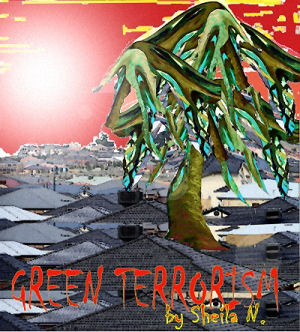
The story so far:
"THEY were labelled law breakers, fined $50,000 and left emotionally and financially drained. But seven years after the Sheahans bulldozed trees to make a fire break — an act that got them dragged before a magistrate and penalised — they feel vindicated. Their house is one of the few in Reedy Creek still standing....
Mr Sheahan is still angry about his prosecution, which cost him $100,000 in fines and legal fees. The council’s planning laws allow trees to be cleared only when they are within six metres of a house. Mr Sheahan cleared trees up to 100 metres away from his house." (Source: Andrew Bolt, "Green rules, black forest"
But the plot thickens...
Apparently NO journalist has contacted the Mitchell Shire Council to investigate its version of the Sheahans' story. However close investigation reveals a much more interesting side to life by the forests and how communities can pull together or apart to preserve or destroy their environment and themselves.
People may read the records for themselves here:
http://www.mitchellshire.vic.gov.au/Files/12_Sept_05_minutes.pdf
The Council records show that before November 2003 the Sheahans cleared an environmental overlay of 1.2 Ha old growth eucalptus (past their fire-prone growth - as could be demonstrated from their size and age), adjoining State forest. In so-doing the Sheahans also created flat ground for their horses.
The Sheahans apparently fell afoul of the local council because neighbours complained about what they had done, which was against the law. So the Council was acting on complaints from neighbours of the Sheahans.
Far from being 'dragged into court' the Council records seem to show that every attempt was made to keep the matter out of court and to resolve it with the least hassle for all parties.
Victims of their own actions?
The records seem to show that the Sheahans were the ones to cost themselves and the Council time and money.
For instance, in an attempt to settle the matter without great cost, the council sought the Sheahans' agreement to pay $2,500 in council costs and to plant some more vegetation. In 2003, they agreed to pay this $2,500 Council and to repair some of the damage by revegetating.
They then failed to do what they had said they would. The council attempted to renew dialogue.
"Get stuffed!"
In 2004 the Sheahans responded to attempts to communicate further on the issue with a letter telling Council and residents to 'get stuffed'.
In 2004 the court case could no longer be avoided.
The Sheahans attempted to convince the council that their motive for felling the old-growth trees in the environmental overlay had been to remove fire-danger. They had, however, left logs piled up in the area where the healthy old trees had been. There is a 2004 photograph which shows that these logs had later been involved in a fire following a couple of bad fire-risk seasons. .
Although the Sheahans have claimed that they bulldozed logs to create a fire-barrier, this was not the opinion of a fire-hazard inspector, who reckoned they had created a fire-hazard. The Council issued the Sheahans with an order to remove the fire-hazard from the property.
Magistrate also not convinced about the 'fire-break'.
In court, the Magistrate held that the Sheahans' claim of a fire-barrier was not plausible because they had “only sought to consider exemptions under the Mitchell Planning Scheme after the fact”.
Due to the efforts of the council and the CFA the pile of burnt logs was removed from the Sheahan property. The fact that the Sheahans survived the most recent fires may be in part due to the removal of the fire-hazard they had themselves created out of trees which had survived many fires intact.
A sore loser by any other name ...
That would make them ungrateful sore-losers, if placed in a kindly light.
It therefore seems to me - going by these records - that, failing some other well-based explanation, it is fair and reasonable to label the Sheahans 'law breakers'.
It also seems reasonable to label the press in this matter, 'pot-stirrers', or something much worse, perhaps, given the gravity of grief and loss in Victoria - the most cleared state of Australia.
What do you think?
In their coverage of this story the mainstream press seem again to demonstrate that they are the mouthpieces of narrow commercial interest by the opportunistic and unbalanced manner in which this matter has so far been reported. Their silence - ABC and commercial alike - is deafening on the truth, which was that the most 'managed' and back-burned forests burned the hottest, whereas much old-growth survived these and many other fires.
With press like this, who needs enemies - or even 'Green terrorists'?
Do the Australian Federal Police answer to Australia or Japan?
By Patsy Crawford
This was an editorial in the Sunday Tasmanian of 1 March 2009.
"It seems only a short while back the Federal Government couldn't state its anti-whaling credentials too fervently.
"Australia would track whale hunters across the seven seas. No killing on our watch, cried a bevy of Government ministers.
"So what happened to those fine words when Australian Federal Police dashed sturdily onto the good ship 'Steve Irwin' last weekend, and, at the behest of Japanese authorities, hauled away written records and videos of whale slaughter?
"The Captain of Japanese vessel 'Yushin Maru No. 3' claims it was rammed.
"The 'Steve Irwin' captain Paul Watson says that if anyone wants to bring charges against him and his crew, that's fine by him.
"The Home Affairs Department has trotted out the feeble excuse it can't respond because the matter is in the hands of the AFP.
"The people of Hobart did a bit of responding of their own, lining up in droves to inspect the 'Steve Irwin' and donate to its cause.
"It beggars belief to think there are countries still clinging to a cruel, outmoded practice that should have been knocked on the head along
with Captain Ahab years ago".
See also: "What whales? Ruddbot's shame" by in the Brisbane Times of 24 Feb 09, "Who called the cops?" by Mark Worley in the Mercury of 22 Feb 09, "Is Kevin Rudd the Neville Chamberlain of Conservation?" by Captain Paul Watson on 28 Jan 09.
Topic:
The Ugly American in Australia



1 July 2005, Telstra share price was AU$5.06. 3.5 years later, Sol Trujillo announced his pending departure [26 February]. With Telstra stock nearing a record LOW on Trujillo's watch - AU$3.68, we're informed that Sol will take with him his AU$13.4-million pay package for this year plus another AU$30-million payout. Plus his eight-digit salary each of the previous three years.
For the past four years, Trujillo spent a significant portion of his time outside Australia, distant from the iconic industry he purports to manage. (Does Trujillo use NextG to manage-from-afar?)
For the past 12 months, he focused intently on landing his next job ... while finishing his promised lay-offs of 12,000 Telstra employees. (Is Trujillo helping them in their job searches?)
Trujillo has spent four years raping and pillaging a major Australian asset, receiving perhaps AU$70- million, while driving down the value of the shares owned by Australian citizens.
I don't know which is more pathetic: The nearly 30% loss in stock value; Trujillo's AU$30-million payout; or Telstra employees learning today about Sol's resignation through its announcement by the media!
Judy Bamberger
| Judy Bamberger | +61-2-6247-6220 (phone, fax) |
| Process Solutions | +61-2-6247-4746 (home) |
| O'Connor ACT 2602 AUSTRALIA | |
| bamberg [ AT ] eaglet.rain.com | |
See also: citizensagainstsellingtelstra.com
Topic:
Pressure on Crown and public land in Melbourne unsustainable - response to Inquiry
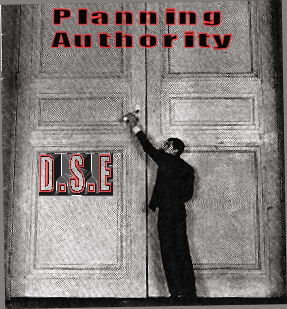
Crucial investigation must not be highjacked by Melbourne's planners and developers
The Victorian Environmental Assessment Council is currently conducting investigation into Crown and Public Land in the Melbourne metropolitan area. Track record of such inquiries mean that only a naive Melbourne citizen would expect anything from this one, other than excuses to confiscate and give away to developers more and more of Melbourne's public land.
For this reason it is important for alternative forums to give as much publicity as possible to the issues in hand. We do this here via one excellent submission, from Jill Quirk, on behalf of the Victorian Branch of Sustainable Population Australia. (Below this report the submission is reproduced in its original form.)
This investigation springs from competition for land-use due to the pressures of population growth

Ms Quirk states, "SPA (VIC) with its particular focus on the interaction of population levels/lifestyle and the environment notes that the investigation into public and crown land has most likely sprung from the pressures of population growth on land use and the increasing importance and competition for the use of this land to a growing population with diminishing private open space available to it."
Ms Quirk's submission highlights what should be the outstanding priority of the report, the problems caused by the State Government's obdurate engineering of a much bigger population. Without this massive population, Victoria's water supply would probably be adequate and the city would be cooler, because there would be fewer buildings, less industrial activity and more trees and green spaces.
Purposes of the Investigation
The purposes of the investigation which the SPA VIC submission addresses are to systematically identify and assess the uses, resources, condition, values and management of Crown land, and public authority land in metropolitan Melbourne; to assess values of Crown land, and public authority land for areas not committed to a specific use, and report on appropriate future uses relevant to Melbourne's livability and natural values; and to report on the contribution of Crown land, and public authority land to Melbourne's livability and opportunities for enhancement of this contribution.
Ms Quirk explained that SPA VIC would urge a broad approach with particular consideration given to the pressure on land- of a rapidly rising population with diminishing private open space.
Melbourne 2030 creates the problems it then purports to resolve
She observed that, "Diminished private open space is prescribed by the Melbourne 2030 urban consolidation blueprint necessitated by projected massive population growth, and she also notes that this projected population growth was under- estimated at the time of design.
On current trends, problems are exponential
This situation makes it necessary to contend with the problem of a very much larger population in the future in Victoria with no end of this growth anticipated.
"At current rates of growth Melbourne could have 8 million people well before the end of the century", Ms Quirk warned.
The problem of encouraging population growth with no end in sight is further complicated by the declining state of the Victorian natural environment (as noted in the 2008 Victorian State of the Environment report).

Urban heat island effect increases urgent need for trees to modify temperature
The inevitable increased urban temperatures in Melbourne from an increasing proportion of built up areas, (Urban Heat Island effect) make the "need for open space with vegetation, especially trees to mitigate or modify increased temperatures at local levels", especially urgent.
Urban water management
"Open space which is not concreted or paved allows maximum absorption of water in to the ground which is important for the health and survival of vegetation in the surrounding area. It is therefore imperative to consolidate and increase permeable open space," Ms Quirk observes.
Democratic representation a factor in environmental degradation
Ms Quirk has called the Enquiry's attention to the fact that democracy is a victim of Melbourne's recent land-use changes. "The impact on democratic rights and democratic structure of centrally engineered changes in use of public land and reduction of public land," she said, and referred to http://candobetter.org/node/628.
Pure environmental value of open land-
Ms Quirk points out that, "There is a pure environmental value of open land."
"A fundamental contribution of land that has not been built over is its capacity to absorb water. Once it has been built over it cannot serve this function. In addition, water shortages through drought and increased demand on our water supplies have resulted in noticeable loss of green areas both in public and private gardens. Thus any that remain are crucial to the health of Melbourne’s urban environment..
"The other contributions of land with vegetation (especially trees) are to cool the immediate environment via shade and transpiration. Heating up of the urban environment has occurred through expansion and densification necessitated through population growth (Urban Heat Island effect) as well as because of global climate change. The cooling attributes of trees and other vegetation create a microclimate of relief in an environment which is otherwise incapable of modifying the effect of summer heat. They thus reduce the need for inside use of energy using air conditioners and other cooling systems.
It must also be remembered that birds and small animals require habitat to survive. e.g. every Grevillea Robin Gordon that disappears removes food for several wattle birds. Public open space has become even more crucial for our wildlife than it was before the massive loss of private open space i.e. private gardens that is well under way.
Public open space has become even more crucial for our wildlife than it was before the massive loss of private open space i.e. private gardens that is well under way.
Value of open space to residents of Melbourne
"With a rapidly increasing population (largely socially engineered by governments- notably state governments by designating nearly all areas in the state as in need of immigration) over the last 10 years, (see http://www.liveinvictoria.vic.gov.au) there has been noticeable pressure on both public and private land. This trend will continue with bipartisan pro population growth stances. Private gardens are being lost at an alarming rate as houses on generous blocks with trees are bulldozed for units and town houses , resulting in a far greater coverage of the land with impermeable surfaces and building, loss of trees, shade and other vegetation This leaves neighbours with less and less relief from built up areas and often owning no garden themselves people rely more and more heavily on public land for recreation. The benefits of open space to people may not always be accurately measured by the number actually on the land at a particular time. The benefit to some may be simply in the relief and reassurance of walking past an open space."
"The value of open land is so much more than the dollar price estimated in terms of what it would yield if subdivided and sold to developers or built on to create a revenue raising venue. It is a defect of our land valuing and legal system that it fails to account for many damages to quality of life through changes to land use."
"We were fortunate in Melbourne that our founders were far sighted in setting aside areas of land for Melbourne’s people. Unfortunately their provisions for future generations have sometimes been exploited for short term objectives (according to Coasian economic values) at the expense of the general population.
These considerations should be uppermost when making assessments with respect to –uses and values of public land. Democratic rights and structure at a local level should be strengthened as opposed to their removal to distant government and commercial forums."
The Final Recommendation made by the SPA Victoria report is that there should be no erosion or loss of public open space from our current situation. It asks that the Victorian Environmental Assessment Council focus on maintaining and maximizing the natural attributes of any land under consideration for the benefit of Victorian citizens present and future.
"We ask that the Victorian Environmental Assessment Council focus on maintaining and maximizing the natural attributes of any land under consideration for the benefit of Victorian citizens present and future."
ORIGINAL SUBMISSION BELOW
The Secretary
Metropolitan Melbourne Enquiry
Victorian Environmental Assessment Council
Level 6
8 Nicholson Street
East Melbourne 3002
16 February 2009
Dear Sir/Madam
Re Investigation into Crown and public land
Introduction:
I am writing on behalf of Sustainable Population Australia: Victorian Branch (SPA VIC).
SPA is an environmental organization whose aims and objectives are:
.To contribute to public awareness of the limits of Australian population growth from ecological, social and economic viewpoints.
.To promote awareness that the survival of an ecologically sustainable population depends on its renewable resource base.
.To help promote policies that will initially lead to stabilization of Australia’s population by encouraging near replacement fertility rates and low immigration rates.
.To promote urban and rural lifestyles and practices that are in harmony with the realities of the Australian environment, its resource base and its biodiversity.
.To advocate low immigration rates while rejecting any selection based on race.
.To help promote policies that will lead to the stabilization, then reduction of global population.
SPA (VIC) with its particular focus on the interaction of population levels/lifestyle and the environment notes that the investigation into public and crown land has most likely sprung from the pressures of population growth on land use and the increasing importance and competition for the use of this land to a growing population with diminishing private open space available to it.
With reference to the purposes of the investigation
(“The purposes of the investigation are to:
(a) systematically identify and assess the uses, resources, condition, values and management of Crown land, and public authority land in metropolitan Melbourne;
(b) assess values of Crown land, and public authority land for areas not committed to a specific use, and report on appropriate future uses relevant to Melbourne's livability and natural values; and
(c) report on the contribution of Crown land, and public authority land to Melbourne's livability and opportunities for enhancement of this contribution”)
SPA VIC would urge a broad approach with particular consideration given to the following:
1. The pressure on land- of a rapidly rising population with diminishing private open space. Diminished private open space is prescribed by the Melbourne 2030 urban consolidation blueprint necessitated by projected massive population growth (which as it turns out was under- estimated at the time of design.)
2. A very much larger population in the future in Victoria with no end of this growth anticipated (At current rates of growth Melbourne could have 8 million people well before the end of the century.)
3. The declining state of the Victorian natural environment (as noted in the 2008 Victorian State of the Environment report)
4. The inevitable increased urban temperatures in Melbourne from an increasing proportion of built up areas, (Urban Heat Island effect) and the consequent need for open space with vegetation, especially trees to mitigate or modify increased temperatures at local levels
5. Urban water management: Open space which is not concreted or paved allows maximum absorption of water in to the ground which is important for the health and survival of vegetation in the surrounding area.
6. The impact on democratic rights and democratic structure of centrally engineered changes in use of public land and reduction of public land. (http://candobetter.org/node/628)
Pure environmental value of open land-
A fundamental contribution of land that has not been built over is its capacity to absorb water. Once it has been built over it cannot serve this function. In addition, water shortages through drought and increased demand on our water supplies have resulted in noticeable loss of green areas both in public and private gardens. Thus any that remain are crucial to the health of Melbourne’s urban environment.
The other contributions of land with vegetation (especially trees) are to cool the immediate environment via shade and transpiration. Heating up of the urban environment has occurred through expansion and densification necessitated through population growth (Urban Heat Island effect) as well as because of global climate change. The cooling attributes of trees and other vegetation create a microclimate of relief in an environment which is otherwise incapable of modifying the effect of summer heat. They thus reduce the need for inside use of energy using air conditioners and other cooling systems.
It must also be remembered that birds and small animals require habitat to survive. e.g. every Grevillea Robin Gordon that disappears removes food for several wattle birds. Public open space has become even more crucial for our wildlife than it was before the massive loss of private open space i.e. private gardens that is well under way.
Value of open space to residents of Melbourne
With a rapidly increasing population (largely socially engineered by governments- notably state governments by designating nearly all areas in the state as in need of immigration) over the last 10 years, (see http://www.liveinvictoria.vic.gov.au) there has been noticeable pressure on both public and private land. This trend will continue with bipartisan pro population growth stances. Private gardens are being lost at an alarming rate as houses on generous blocks with trees are bulldozed for units and town houses , resulting in a far greater coverage of the land with impermeable surfaces and building, loss of trees, shade and other vegetation This leaves neighbours with less and less relief from built up areas and often owning no garden themselves people rely more and more heavily on public land for recreation. The benefits of open space to people may not always be accurately measured by the number actually on the land at a particular time. The benefit to some may be simply in the relief and reassurance of walking past an open space.
The value of open land is so much more than the dollar price estimated in terms of what it would yield if subdivided and sold to developers or built on to create a revenue raising venue. It is a defect of our land valuing and legal system that it fails to account for many damages to quality of life through changes to land use.
We were fortunate in Melbourne that our founders were far sighted in setting aside areas of land for Melbourne’s people. Unfortunately their provisions for future generations have sometimes been exploited for short term objectives (according to Coasian economic values) at the expense of the general population.
These considerations should be uppermost when making assessments with respect to –uses and values of public land. Democratic rights and structure at a local level should be strengthened as opposed to their removal to distant government and commercial forums.
Recommendation: that there should be no erosion or loss of public open space from our current situation and we ask that the Victorian Environmental Assessment Council focus on maintaining and maximizing the natural attributes of any land under consideration for the benefit of Victorian citizens present and future.
Sincerely,
Jill Quirk
President: Sustainable Population Australia (Victorian Branch)
Contact: Via candobetter.org or by post to PO Box 1173 Frankston (for public correspondence)
20 Feb 2009
Wilsons Promontory – DSE fire management risking local extinctions
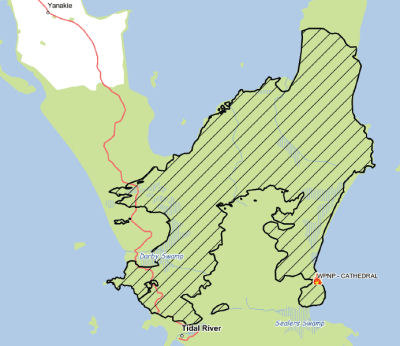 Over two weeks since lightning struck the east coast of Wilsons Promontory on the Cathedral Range just north of Sealers Cove, most of the northern half of ‘the Prom’ has been burnt. The Victorian Country Fire Authority (CFA) website reports 23,000 hectares burnt out. The Department of Sustainability and Environment (DSE) website shows the following map of the burn (shaded area below). The fire has burnt the Cathedral Range, along the east coastline right across and along the Corner Inlet shoreline to Millers Landing.
Over two weeks since lightning struck the east coast of Wilsons Promontory on the Cathedral Range just north of Sealers Cove, most of the northern half of ‘the Prom’ has been burnt. The Victorian Country Fire Authority (CFA) website reports 23,000 hectares burnt out. The Department of Sustainability and Environment (DSE) website shows the following map of the burn (shaded area below). The fire has burnt the Cathedral Range, along the east coastline right across and along the Corner Inlet shoreline to Millers Landing.
Prom Fire Was Nearly Out
The Wilsons Promontory bushfire was reportedly sparked by lightning striking the remote Cathedral Range on the east coast just north of Sealers Cove on Sunday 8th February 2009. Witnesses say that by the following Friday 13th, the fire was still localised on the Range and all but out. This is confirmed by the following satellite photo taken by NASA's MODIS Rapid Response Team on the 13th. The satellite takes high-resolution images of visible, shortwave and near-infrared light of Victoria twice daily.

Wilsons Promontory on 13th Feb, showing scattered cloud over the Prom and on the east coast (right side) a small red (burnt) patch with only a single column of smoke noticeable. © NASA 13-Feb-09
Daily updates of this fire can be found at the following URL:
http://www.nasa.gov/mission_pages/fires/main/world/australiafire_20090223.html
Left to Burn?
Over the subsequent days the fire continued to burn then the winds increased. Now, more than two weeks later most of the northern half of ‘the Prom’ has been burnt. The vegetation has gone. The Victorian Country Fire Authority (CFA) website today reports 23,800 hectares burnt out. The Department of Sustainability and Environment (DSE) website shows the following map of the burn (shaded area below).

© DSE Wilsons Promontory Media Map 24 Feb 09 12:30pm
The fire has burnt the Cathedral Range, along the east coastline right across and along the Corner Inlet shoreline to Millers Landing. Affected sites are Vereker Creek, Whiskey Bay, Tongue Point, Monkey Point, Three Mile Point, Mt Roundback, Three Mile Beach, Mt Margaret, Lighthouse Point Lighthouse, Mt Hunter and parts of Darby Swamp. Wilsons Promontory National Park is just one of the many important natural and wilderness areas of Victoria devastated by these current bushfires.
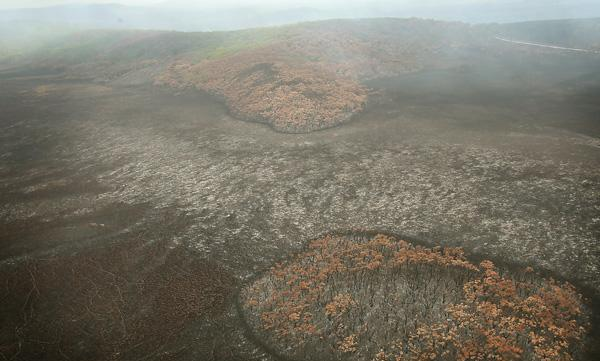
Wilsons Promontory where thousands of hectares have been burnt.
© Photo. John Woudstra 18-Feb-09
Frequent Fire History
In the case of the Prom, this is the second time in four years that fire has burnt through this northern region. On 21 March 2005, a twenty hectare prescribed burn was lit east of Tidal River. It escaped three times over a period of twelve days and burnt out 6,000 hectares of native bushland in the National Park.
A key investigative report was undertaken by Commissioner, Emergency Services, Bruce Esplin, (the Esplin 2005 Report) into a number of fires over previous years. In the case of this DSE prescribed burn in the Prom, the investigations found that the prescribed burn was poorly planned and after ignition, was not patrolled properly.
A notable finding of the report was that: “There remains considerable community uncertainty about the effectiveness of the prescribed burning program, and what changes, if any have occurred in the amount of prescribed burning undertaken since 2003”.( para 33)
Yet prescribed burning continues each year across Australia, not in the small mosaics, but on a grand scale and with a record of frequently getting out of control. On top of the 6,000 hectares four years ago, just a few days ago we hear of over 23,000 hectares of the Prom has now been burnt. Fires in the Prom also occurred in 2001.
Impacts on Flora and Fauna
The Prom has diverse vegetation communities including warm temperate and cool temperate rainforest, tall open forests, woodlands, heathlands, and swamp and coastal communities. There are rare stands of White Mangrove, being the most southerly stands of mangroves in the world.
The Prom is rich its diversity of native mammals with over thirty species having been recorded, many of which are either rare or threatened. These include the Long-nosed Potoroo, Swamp Antechinus, White-footed Dunnart, Broad-toothed Rat, Feather-tailed Glider and Eastern Pygmy-possum. “One of the most significant habitats of the New Holland Mouse also occurs within the park, and a number of species of whale have been sighted in the waters off its coastline.” The Prom also provides habitat to populations of Eastern Grey Kangaroos, koalas, wombats and emus.
The heathlands, influenced by the frequency and intensity of fire, are rich in species and provide habitats for a variety of fauna, including many threatened species. [Source: Parks Victoria website]
However, bushfire research across Australia has shown that while some native flora are fire tolerant and/or can recover and in some case thrive in the immediate years following a fire, other species have not adapted and so they become displaced and can die out. (DSE website).
While the Victorian Royal Commission is focusing on the fire management measures to protect life and private and public property associated with the 2009 Victorian Bushfires, the impacts on flora and fauna seem to have been overlooked. Some species may not survive if fires are too frequent, as the plants are unable to reach maturity and produce sufficient seed before the next fire episode. (DSE website).
Threatening Process
Little is known about the recovery of fauna diversity as a consequence of such widespread bushfires, be they caused by lightning, intentionally or otherwise. But given the scale of these current fires across the Prom crossing from shore to shore, it is probable than many native animals, as in many other parts of Victoria, will have been burnt alive in the fires and that their already rare populations will now have declined substantially and be at risk of local extinction.
In respect to Australia’s fauna, given that there we now have a fraction of the intact native habitat compared with pre-1788, how can anyone argue that allowing bushfires to get out of control is not a threatening process?
Woodchip cargos drifting offshore without buyers
An independent analysis of The New Residential Zones for Victoria
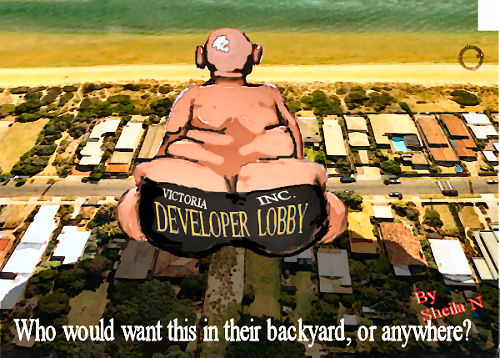 Editor's introduction. We were amused to read of this report in the Age and it seems a fitting introduction to the analysis below by A.H. of the infamous 'New Residential Zones for Victoria.
Editor's introduction. We were amused to read of this report in the Age and it seems a fitting introduction to the analysis below by A.H. of the infamous 'New Residential Zones for Victoria.
"NIMBY mentality holding us back:
JASON Dowling (Comment & Debate, The Age, 20/2/09) outlined some prime examples of how Victoria's "not-in-my-back-yard" mentality is damaging the modernisation of our state. The disruption to development timetables caused by frivolous complaints often delays essential community projects for months. Master Builders Association surveys show planning delays average over 20 weeks and push up the cost of new homes significantly. More than $1 billion in community projects are held up in the planning system now.
We do not support open-slather development. Municipalities have the right/obligation to set the strategic planning framework. Thereafter, the interpretation should be left to people who can dispassionately interpret whether projects fit within the framework.
The State Government's plans to fast-track some of these projects will help provide essential community infrastructure, underpin 194,000 building jobs, and provide greater certainty for Victoria's building industry. Brian Welch, executive director, Master Builders Association of Victoria"
The DEVIL is in the detail. What every residential property owner should be aware of:
SUBSTANTIAL CHANGE ZONE
• The name says it all, open slather, free range for development, Substantial Change. Money for jam for all developers. NSW style development. Anything goes. Let it rip!! You bewdy!! Towers, Towers, Towers etc. You know what it means. This is where we stuff the 1000 new residents who come to Victoria each week to live, if we can, and some in the other zones too. In 5-10 years this Zone won't be the same. Substantial means just that, Substantial Change. No further explanation needed or required.
INCREMENTAL CHANGE ZONE
• The information sheet (bottom of cover page) dated February 2009 states “The Incremental Change Zone allows for a variety of housing types including medium density. housing provided that it respects the character of the neighbourhood”
• However, upon reading the description of the Incremental Change Zone it states: “Purpose. To provide for residential development at a range of densities with a variety of dwellings to meet the housing needs of all households”.
• NOTE: Information sheet says Zone is to provide “medium density”, yet in the Zone description the word medium density suddenly becomes “range of densities”. Medium density is not mentioned in the description of the Incremental Change Zone at all.
• Question: What is a range of densities? Is that like free-range eggs, big ones and small ones?
Subdivision of Land
Exemption from Notice and Review (Appeal to VCAT)
• An application to subdivide land is exempt from the Notice requirements (you don’t get told about any Subdivision). The decision about the application and your existing review rights to VCAT are exempt. (You don’t know about the decision and no longer have any right to have the decision reviewed by VCAT)
Construction and extension of one dwelling on a lot
Exemption from Notice and Review (Appeal to VCAT)
• An application for construction and extension is exempt from the Notice requirements (you don’t get told about any construction and extension). The decision about the application and your existing review rights to VCAT are exempt. (You don’t know about the decision and no longer have any right to have the decision reviewed by VCAT).
LIMITED CHANGE ZONE
Purpose: To ensure residential development protects the neighbourhood character of the area.
Subdivision of Land
Exemption from Notice and Review (Appeal to VCAT)
• An application to subdivide land is exempt from the Notice requirements (you don’t get told about any Subdivision). The decision about the application and your existing review rights to VCAT are exempt. (You don’t know about the decision and no longer have any right to have the decision reviewed by VCAT)
Construction and extension of one dwelling on a lot
Exemption from Notice and Review(Appeal to VCAT)
• An application for construction and extension is exempt from the Notice requirements (you don’t get told about any construction and extension). The decision about the application and your existing review rights to VCAT are exempt. (You don’t know about the decision and no longer have any right to have the decision reviewed by VCAT)
BOTTOM LINE:
• The Brumby Government is attempting to take away property rights in all three proposed Zone changes, which home owners have had for many years. These rights include, the right to be notified of an Application, the right to object to a development, and where necessary, seek a review of the decision made by the Council at VCAT. In these three Zone proposals, each homeowner is being done over by the politicians. There is no Government mandate for this style of change which was never mentioned at the last state election by the Bracks now Brumby Government.
• We employ the politicians. We are their masters not the other way round. Kick butt!! Do you know who is your State member of the Legislative Assembly and the other lot in the Legislative Council. (Look under Parliament in the Business White Pages) or Google: Victorian Parliament.
• It’s your property. Don’t leave it up to someone else. Express your concern to your employee the politician! Do something now. Defend your property rights whilst you still have them .
• Soon it may be too late other than to say “there goes the neighbourhood!”. Now is the time for all Good Men and Women to lay siege to their State Member of Parliament whatever their political persuasion maybe and defend the home-owner’s piece of paradise. The game is not over yet. We must all stand shoulder to shoulder like any Victorians and fight this proposal which will change our lives forever. Bad public policy is just that, Bad. These proposed changes are designed to appease the usual suspects, the Property Council of Australia, the Master Builders of Victoria, the Housing industry Association and the Institute of Public Affairs. Will you willingly relegate your property rights to these vested interests? Will you sit by whilst the above-named culprits receive a leg-up and financial windfall at your cost. It's time to attack the Brumby Government with all our fortitude and get rid of these new Zones.
A.H.
Governments taking the 'conservation' out of conservation management
In Victoria in 1992 some bureaucrat got the idea of changing the name (and focus) of the Department of Conservation and Environment to a Department of Conservation and Natural Resources, then in 1996 to a Department of Natural Resources and Environment, then in 2003 a split to (1) a Victorian Department of Primary Industries and (2) a Department of Sustainability and Environment. 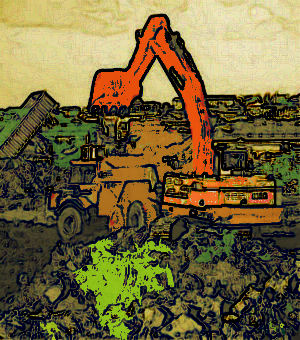
Source: http://www.austehc.unimelb.edu.au/asaw/biogs/A002037b.htm
Currently it's known by its obscure acronym DSE...(Don't Support Environment, or Department of Sparks and Embers).
Across the border in NSW, in 2007, the Department of Environment and Conservation was changed to the Department of Environment and Climate Change (DECC). Rather than forming a dedicated research and response organisation to focus on climate change, the conservation was dropped from the existing department. Cynically, including 'climate change' as a name of one of its departments, government must feel cosy sending a message it is addressing climate change. For a while the department was headed up by The NSW Minister for Climate Change, Environment and Water - a bucket of outdoor type activities that sounded good together.
Across the border in South Australia, they have the Department for the Environment and Heritage (DEH), which sounds borrowed from the federal Department of the Environment, Water, Heritage and the Arts (another collective bucket). It is hard to see how with so many diverse portfolios, a minister can dedicate any leadership to making genuine improvements to what's left of Australia's intact natural environment and its desperate need for conservation.
With all the money spent on names changing, the tens of thousands could have gone into onground conservation activities like fox control programmes.
Nearly half of Wilsons Promontory burnt due to CFA neglect
I have been monitoring the Jan-Feb 2009 Victorian bushfires from NSW and have turned my attention to the bushfire management in a natural area - Wilsons Promontory. I note satellite observations of the fire with concern showing the lighting ignition on the east coast started 9th February, but had almost extinguished itself by the 13th. Then a wind change drove it out of control. A week later it has burnt out 22,000 hectares (almost 50% of our precious 50,000ha Prom)!
While the Country Fire Authority (CFA) has paid special attention to non-imminent bushfire risks to rather distant private property. The CFA says "the fire does not currently pose a threat to the Yanakie community." Backburning the Prom is given as the only bushfire response strategy. So do we interpret this as a noncommittal response by the CFA for the Prom - that is since no human lives or private property are at threat, the CFA's bushfire response is to just 'monitor' the fire and put out the spot fires threatening private property to the north?

The CFA reports read as though CFA policy for active and damaging bushfires in important conservation areas is to wait for rain, but otherwise 'let it burn'.
And yet the Bureau of Meteorology forecasts hot and windy conditions for tomorrow Monday, 23 Feb 2009.
I interpret this bushfire management by Victoria's CFA as one that respects only human life and property, but does not rate the natural asset values of fauna and flora habitat of the Prom with any respect. It seems at best an opportunity for de-facto hazard reduction that it would normally not get permission to do, and at worst an inconvenient distraction for CFA crews.
If this is the prevailing attitude of rural firefighting then clearly the CFA has no interest in natural assets, and no mandate to protect them from fire in the same passionate way it does private property? There seems no difference in approach or skill set by the CFA to that that would be exercised by urban fire brigades.
So why do we have a CFA? Professional fire brigades are expensive, whereas volunteers are cheap is the political answer!
On this basis, it is overdue for the CFA to be incorporated within the urban fire brigade structure. While this initial structural change won't save Victoria's vast tracts of wildlife habitat in the short term, it will sure will remove the false premise to the community that the CFA respects and defends natural wildlife habitats.
What does Victorian Government's Department of Sustainability and Environment have to say for itself? It is charged with the Promontory's protection.
See also: "Crews unable to slow Wilsons Promontory blaze" on ABC online on 17 Feb 09, "Huge blaze threatens the very heart of the Prom" in the Age of 19 Feb 09.
Heatwave-hundreds dead - Government population policy made water & power shortages worse
Immediately after the first record-breaking heat-wave in Victoria - before the major fires - the Coroner came out and said that the death rate had increased noticably. [1]
Illustration from an oil portrait by Sheila Newman of Barry Jones, Chairman of Australia's Population Carrying Capacity Inquiry, 1994
Government policies made Melbourne residents vulnerable to extreme weather.
Deaths from heat-related illness, with power-supply failures to homes relying on air-conditioners and fans as their sole means of cooling, and dry gardens exacerbating vulnerability to fire, can all be related to the push by three successive Victorian governments and two Federal governments to increase Australia's population numbers.
In Melbourne, the ambulance service responded to 1600 jobs a day, double the normal figure of 800.
Ambulance worker, Mr Holman said the heatwave's impact was sharpened by the loss of power, and therefore lack of air conditioning, in parts of the state and concern that some hospitals would have to be evacuated."[1]
The policy of increasing urban density also increased the intensity of urban activity, which creates heat.
The style of many new houses is antithetical to sensible architecture for Australia. The lack of eves or verandas runs counter to soundly-based local culture. Thin walls, big glass windows without shade and tiny tree-less concrete yards packed closely together provide little defense against direct sunlight or drying winds. The sealed surfaces absorb heat and give no opportunity for water or plants. Air-conditioners have become common. Unfortunately, they pour heat into the atmosphere, raising the temperature again. What other choice did some people living packed in badly designed mass-produced housing or cheap sub-standard accommodation in our overpriced rental-market have? And what chance did they have when the power-supply failed due to predictable and exploited for profit over-demand?
Other factors worsening our chances in Melbourne would be allowing the practice of moon-scaping, i.e. the removal of cooling trees to facilitate the construction of new housing estates. (One willow, for instance, has been described as "equivalent to 28 reverse cycle air conditioners. They absorb a tremendous amount of heat from the sun and convert it into cool moist air. At night, if the wind in not too strong all that moisture comes back down to earth and settles on the cool vegetation and warms the local climate. It won't happen if the ground is hot and barren....it doesn't rain too often on a desert." - Comment from farmer on Natural Sequence Farming forum) It is well-known that the soil loss entailed by moonscaping also releases enormous amounts of carbon contained in topsoil.
Predictable water scarcity with unfair restrictions could all have been avoided and were foreseen
And then there were the restrictions on using water to facilitate this much resented process of urban intensification. For, as various premiers kept on stating so cynically, we would not have enough water for the population growth if we did not cut back, cut back more, continue to cut back.
Even more cynically, state politicians gave the impression that they had no control over the population growth. And some of them (e.g. Steve Bracks) simultaneously pretended that deaths were outnumbering births, whilst stating that we had to have more houses for the growing population. This absurdity was allowed to go unchallenged on the ABC on Jon Faine's program.[2a] (Indeed, the ABC sounds more and more like a real-estate promoter.)
No slack was left in the system by people supposed to be professional planners!
The power failures and the water restrictions would not have been necessary if we had not increased our population beyond the capacity to supply Victorians with adequate and affordable power and water.
No slack was left in the system. Scientific caution and citizen welfare were jettisoned for pie-in-the-sky about "Future generations" and various spokespersons spoke in a mealy-mouthed way about virtuous reductions in personal water-use. Industry kept expanding its water-use at the same time, with little information available about this to the public.
Just before the heat-wave and the fires the State of the Environment Victoria Report came out, supposedly lambasting the government for our mutilated environment, and warning that human population growth was placing the greatest demand on this environment which sustains us, bringing us close to eco-collapse. However the Commissioner, Dr Ian McPhail, then gave the government the go-ahead to continue this insane growth. What is the responsibility of the Chairman and the participants in this report for business as usual and its consequences?
And then the Victorian ALP started to let Victorians know that the one million more people it had already dictated Melbourne citizens should submit to had overshot disasterously! At one stage Brumby mumbled something about perhaps we had had enough iimmigration - but never, at no stage, was reducing the rate of immigration allowed as a serious response. In Parliament the matter was treated. ridiculously, as one of 'too many guests invited to a BBQ' which we would all have to make welcome. Later, Brumby attempted to turn the dire situation of overloaded public transport during the petrol-price hikes to media advantage in Parliament, by boasting that more Victorians than ever were using public transport.
Even as late as 20 February, 2009, Federal Minister, Julia Gillard, was rejecting the idea of reducing our record high immigration in a half-dead economy. Then, on 26th of January, around 9.24am, Mr Brumby was asked by the populationist ABC radio announcer, Jon Faine, who was referring to loss of manufacturing jobs, "Do you think there should be cuts to immigration?"
Brumby- (pause and nervous cough- followed by approximately these words.)
"I said last year- we have been growing very fast the time is now to cruise along-not have our foot on the accelerator.
We don't need to increase immigration going forward. Our immigration figure in the last year was about 200,000
I say this number is about right for Australia."
So, who is responsible for power failures and water shortages and deaths from exposure to merciless heat in a city that has overshot its power and water supply? Who is responsible for the role that dessication of gardens may have played in the recent bushfires? Who is responsible for overshooting supply from the Thompson dam? Who is responsible for the empty recreational waters in numerous country towns, which could not pay the skyrocketing water-prices? Who is responsible for allowing community-built and paid-for public swimming pools to be closed down in hot suburbs like Sunshine, Footscray and country areas like Wodonga (several more examples) whilst nearby huge new housing estates privately franchised small indoor pools over which the community had no control?
And who paid the cost of these ridiculous and dangerous policies and turned a blind eye to their impact on democracy and survival in Melbourne and Victoria's towns?
What legal recourse do the families of the victims of imposed water and power shortages have?
What do the families of the victims of these dangerous and dictatorial policies have to say?
What costs can they demand from the government?
Who is responsible?
In my opinion, those who persistently, year after year, drove, promoted and marketed population growth are responsible. The authors of the Victorian government netsite inviting immigrants to come and live in Melbourne, the demographers who lent their 'expertise' to the growth lobby, and those media-presenters who always invite the pro-growthers to speak and make out that those who object to population growth are racists - thus frightening people from speaking up. Also those politicians and planners, and the policy reviewers, who resisted community objections, facilitating Melbourne 2030, and gave the impression that they had the authority to visit this burden upon us - and did - are responsible. They are all the more culpable for persisting year after year amid warnings of climate change. And what about those lobby groups, business-groups, and their representatives, who egged our governments on? (See:, /node/623, /node/569, /node/431, /node/421 - and more - for a rich source of suspects.)
High costs engineered and approved by government
The rising costs of necessities - notably power, water and shelter (homes) - is also related to demand, and this rising cost is another factor which discourages citizens from using enough water to keep their gardens moist, take baths and extra showers, or fill pools and ponds.
But the government has quasi-privatised power and water, which makes the situation so much worse. For instance the sector that provides power from electricity generators is now complaining that they cannot get bank-funding because of Rudd's mooted emissions trading plans. Why on earth did the government sell these generators off in the first place - leaving people hopelessly out of their depth in the private sector trying to make a profit from unsustainable fossil-fuel burning in the middle of a credit crunch, whilst the rest of us wait nervously for the next power failure? (See Annabel Hepworth, Katja Buhrer and Mathew Dunckley, "Climate plan hits power refinancing", Australian Financial Review, 25 February, 2009, p.1.)
Estimating water catchment capacity should be done with high and low rainfall records in mind, erring on the side of safety. This basic public health precaution has been completely ignored by government policy, which has done the opposite. And what has the government done about this engineered predicament? It is insisting on building a desalination plant in the middle of a closely-knit community, from which the transport of water over hundreds of kilometers, will require - MORE ELECTRICITY!
The government ministers, planners and economists involved in 'managing' our State's population overshoot of water and power supplies should be suspended from employment and publicly placed on trial for gross negligence towards Victorians' welfare, contributing to death and suffering.
Risk well-known last century and Danger signs obvious for more than 10 years
Victoria's Thompson Dam, which took ten years to fill, was once adequate for a population of around 15m people, which was the population of Australia in 1983, at the time of its completion.
It is not adequate now.
Between 15m and 21.5 million there were many chances to stop, but we were dragged onward by political desperados.
All Australian parliaments have had access to loads of information from scientists and historians that Australia would run into water-shortages if it grew its population past around 20 million people. The danger signs have been neon-lit for the past ten years. Changes to our climate already have reduced our carrying capacity and our economic viability (which both rely on our environment). Nothing we have done, no technology, has succeeded in reversing this process.
Vast body of literature on Australia's limited population capacity has been ignored at our peril by government
Taylor (1880-1963) argued that Australia could never support more than 65 million people due to its biophysical limitations. He later amended this to 20 million, assuming much higher per capita living standards. Not only does Taylor seem to have been the first to publish the connection between population numbers and affluence (consumption) against the background of local biophysical characteristics and constraints, but he eerily predicted the likely population of Australia as no more than 20 million in the year 2000.[2]
It was not until 1968 [a date coinciding with the release of Ehrlich's Population Explosion], that Australia's huge post-War immigration program began to be questioned in the light of its contribution to population growth and environmental impact.
Subsequently, between 1975 and 1994, there were seven national enquiries and reports which purported to or actually did examine the population question within the scientific context of environmental impact. Five were The National Population Enquiry (Borrie Report) 1975, which paid lip service only, The National Population Council Report 1992, which recommended a population policy; between 1990 and 1992, The National Greenhouse Response Strategy and The National Strategy for Ecologically Sustainable Development, which identified nine elements of a population policy consistent with ecologically sustainable development;[3a] and The Ahrlburg Report 1994, on the foreign aid implications of the economic impact of unrestricted population growth.
The Australian movement, Australians for an Ecologically Sustainable Population, which tried to have a scientifically-based philosophy, was formed in 1988. In 1994 an Australian Academy of Science symposium recommended early population stabilization on ecological, economic and quality of life grounds. The Australian scientific research center, CSIRO, began the 'Ecumene project,' an internationally-linked population modeling and projection study using environmental and economic data (discontinued by the Howard Government). In that same year Tim Flannery published his Australian best seller, The Future Eaters,[4] a scientific work on the ecological and economic evolution of Oceanic countries, which advocates a long term goal for Australia of between six and twelve million people.
Also in 1994 the Australian Population "Carrying Capacity" Report,[3]the "Jones Report" - chaired by Barry Jones), was published. More than 90 percent of submissions, including those from Aboriginal organizations, argued against population growth. The Inquiry's inspired recommendation was to separate political and administrative responsibility for population and immigration (to avoid contamination with racial issues). Immigration intake should become an instrument of population policy, rather than population policy a "long term side effect of ad hoc immigration policy."
The (then) Labor government, with Senator Bolkus heading immigration and ethnic affairs (who had promised the ethnic vote to the Prime Minister of the day, by favoring family reunion and a high migration program), could not deal with the "Jones" report. The Chairman Barry Jones was also the national president of the Labor Party. All hell threatened to break loose if the matter was put to parliamentary debate. An election was imminent. In the interests of Labor's return to power it was decided to keep a lid on the issues for fear of losing the ethnic vote. Jones expressed his opinion that the environmental vote would easily compensate for the ethnic vote, but failed to convince the Prime Minister.
In September 1995 the Government published its response to the 1994 United Nations International Conference on Population and Development. This reactionary document was the work of the Department of Immigration and Ethnic Affairs. It was also the Labor government's only reference to the matter of national population policy, which it rejected as too controversial. Other issues raised at Cairo were dealt with in a superficial manner and with only token reference to the environmental connection.
In March 1996 the Labor government was resoundingly voted out of power.
The Howard Government which followed came in partly because voters thought it less likely to rely on high immigration and practices like ethnic branch-stacking, which were disorganising the democratic organisation and representation of communities. Initially the Howard Government placed emphasis on skilled immigration as a means of 'controlling the numbers'. Unfortunately, after the Bracks Government "Melbourne Population Summit, " the Federal Government appeared to cave into the mass of pressure by developer-aligned media to raise immigration. The Howard Government raised immigration to the highest levels ever known and made these very difficult to estimate by dismantling the statistical series which Australia had kept since first settlement (a nearly unique credential for our country.)
After the Howard Government lost power, Rudd's labor government came in with the 2050 summit, which, in guise of a debate, guided the marketing of more policies to increase more rapidly Australia's population.
Do not for a minute think that the State Governments of Australia had no control over this. The opposite is true; the majority redefined their states and even their cities, as 'regions in need of immigration' - a terminology previously reserved for country areas. The Treasurer, Mr Lenders, once said that he didn't think that it was the job of government to determine how big Melbourne grew. Yet that is exactly what the Victorian State Government has been doing.
All these politicians responsible for growing our population had the information at their fingertips that what they were doing was dangerous. But they went ahead against every public and private objection.
Indeed, my own predictions are right on course, with more horror to go if we keep on growing our population. Please read them for it can only get worse.
Behind all this was the Growth Lobby and I think it is reasonable to say that this lobby has taken control of every level of government in Australia. That is not to say that the government has lost control of policy, it means that the Government is now indistiguishable from the Growth Lobby. WE have lost control of it. Commodification of everything and speculation on population-fed inflation and scarcity has been normalised - by the media and by those whom the media have allowed the publicity to have a good chance at entering parliament.
This is why it is so important for you to support alternative media like candobetter and to assist independents to run for government. I draw your attention now, for instance, to the fact that James Sinnamon, the owner of Candobetter, is running for State Government as an independent in Queensland for the election scheduled in less than 4 weeks time. We need lots of independents in every state. We also need lots of help with candobetter, which is entirely voluntary.
Notes:
[1] http://www.theage.com.au/national/heatwave-left-hundreds-dead-20090221-8ea4.html?page=-1 Heatwave left hundreds dead Melissa Fyfe, The Age February 22, 2009:
"January's brutal heatwave may have killed 100 Melburnians - and more than 200 people across south-eastern Australia - an ``invisible tragedy'' now the subject of investigations by the Department of Human Services and the Coroner's Office. "A Monash University analysis of the event in late January - when temperatures rose above 43 degrees for three consecutive days - indicates the heatwave claimed hundreds of lives across Victoria, South Australia and northern Tasmania.
Ambulance Victoria operations manager Paul Holman said the service went into major disaster mode during the heatwave and was busier than at any other time in the service's history, including during the bushfires.
In Melbourne, the ambulance service responded to 1600 jobs a day, double the normal figure of 800.
``People have forgotten about the heatwave, but it had more of an effect on us than the bushfires,'' Mr Holman said.
``We did more jobs in those four days than we had ever done before.'' Mr Holman said the heatwave's impact was sharpened by the loss of power, and therefore lack of air conditioning, in parts of the state and concern that some hospitals would have to be evacuated."
"Data from the Coroner's Office reveals that his figures are probably too conservative. Deaths reported to the Coroner during the heatwave were 2.5 times more than at the same time last year."
"The Alfred hospital reported a 70 per cent rise in admissions, with many patients arriving in the days after the heatwave suffering cumulative effects.""
[2a] Jill Quirk of Sustainable Population Australia, Victorian Branch, wrote to Faine and to Bracks about this, but was not offered a spot on Faine's program to counter the dangerous misinformation and never received a reply from Mr Bracks, former Premier of Victoria. Mr Faine suggested that she try to ring up and put this as an informal comment, unplanned and unassisted, to his show.
[2] T.G.Taylor, 1922, "The Distribution of Future White Settlement," Geographic Review, 10[12] 375-402 and T.G. Taylor, 1937, Environment, Race and Migration, Toronto UP, Toronto.
[3a] "Jones Report," (See note [3]) p.12
[3] Australian Population "Carrying Capacity Report" - One Nation, Two Ecologies, AGP, 1994, p.8. Chaired by Senator Barry Jones, and known herein as the "Jones Report."
[4] 35 Tim Flannery, The Future Eaters, Reed Books, 1994. (Flannery occupied the Chair of Australian Studies at Harvard University in 1998.)

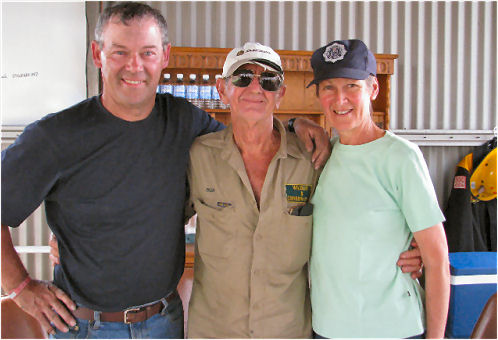

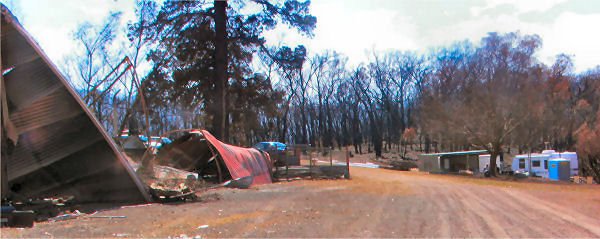

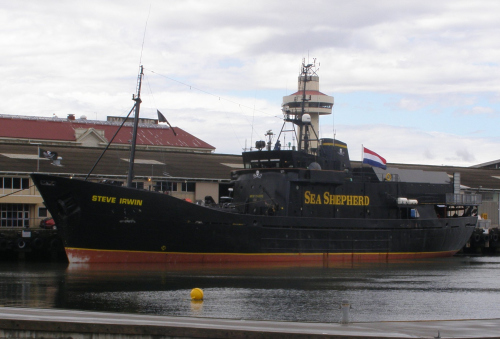
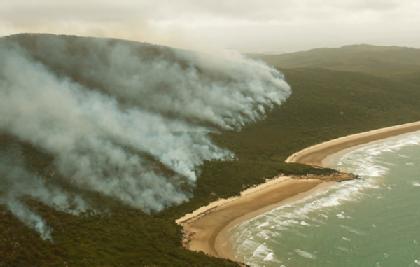
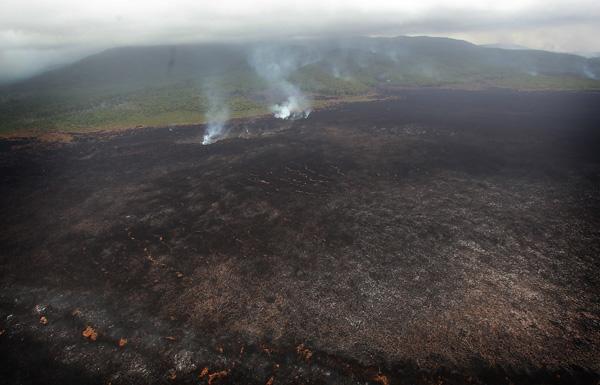

Recent comments